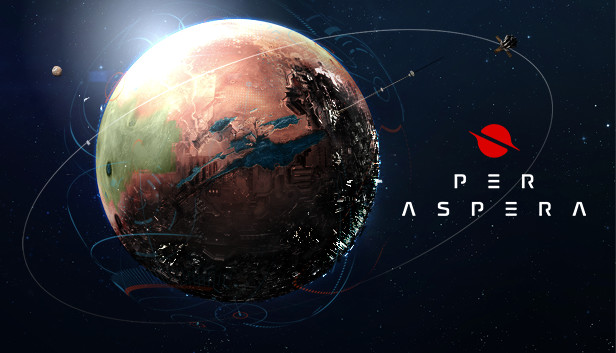This guide covers how to work with the logistics system used in this game instead of against it, as well as a detailed walkthrough of how to beat the first attack in the campaign.
Introduction
The “Too Long; Didn’t Read” version of this guide: Build more worker hubs. Make sure that they have drones attached to them. Done — please leave a 5 star review, thanks! 🙂
Note that this guide is broken into two major sections — the first portion is free of story spoilers, and only contains minor tech tree spoilers. The second section is a step-by-step walkthrough applying the lessons of the first section — it, obviously, does contain story-line spoilers.
The logistic system in this game is highly similar to the logistics system used in the game Settlers 2[en.wikipedia.org]. However, in that game haulers (the equivalent to worker drones) cost nothing to produce and gameplay all but forces you to use them in vast numbers. Typically, a Settlers 2 game will involve 5-10 haulers / building. The author always wondered why haulers were free; this game proves why. 🙂
Are your mines stalled due to full outputs? Either you don’t have enough demand (in which case it shouldn’t be an issue) or you need more worker drones.
Are your factories stalled for resources? Either you don’t have enough mines (a legitimate resource shortfall), or you need more worker drones.
Are your factories stalled due to full outputs? Either you don’t have enough demand (in which case it shouldn’t be an issue) or you need more worker drones.
You get the picture — in Per Aspera, the solution to most problems is “Build more worker drones”. I know it seems like you should conserve resources, and only build worker drones where they are “really needed” but if you approach the game in this direction you are going to find yourself extremely frustrated. You can and should expect to build at least one drone hub per other building to ensure the smooth flow of resources in the game.
Logistics basics
Each drone hub can host one, and only one, drone. This drone is automatically assigned a territory, based on the road network (also automatically generated) and the presence of other drone hubs that have a worker drone present. Keep in mind that the game will automatically redraw territories as new drones are assigned to drone hubs and existing drones are destroyed (by tick damage, simulating the harsh Martian environment). Adjusting the territories in this way ensures that all nodes can be serviced by at least one drone.
Drones can “service” (pickup goods from or deliver goods to) any node that is contained within its territory and the nodes immediately adjacent (connected by a road) to its territory.
The actual process of shipping goods is straightforward:
- The drone checks to see if there are any goods that it can reach that it can assist with moving (“ship”). If there aren’t any, it returns to the drone hub and idles.
- If there are multiple goods that it can ship, it first checks the destination of the goods. If one or more of the goods waiting for shipping is destined for a building with the priority flag, it will choose one of those goods to ship.
- If at this stage there are still multiple options of goods to ship, then it chooses one according to an obscure algorithm that I have no insight into. At a guess, it includes several factors, including minimizing travel time (if there is a good to be shipped in the same node as the drone it will almost always move that good next, for example) and likely how long the good has been waiting for shipping.
- The worker travels along the roads to the node where the good to be shipped resides.
- The worker picks up the good and travels to the selected destination, where it drops it off.
- The process repeats.
There are some things that are still unclear to me (developer feedback would be welcomed here) — in particular, it isn’t clear whether the route that a good will follow is fully determined at the time that the good starts its journey, or the path is recalculated each time a drone considers shipping a good. I suspect that goods recalculate their path each time a worker picks up the good, but maybe not.
In any case, keep in mind that the good can be picked up from outside its territory and delivered to a node outside its territory — this will happen more often than not.
Worker hub territories explained
I started a new game (Campaign, Normal difficulty) and proceeded through the game until I got to the point where the game gives you enough resources to choose your own path. At that point I recommend that you do this:
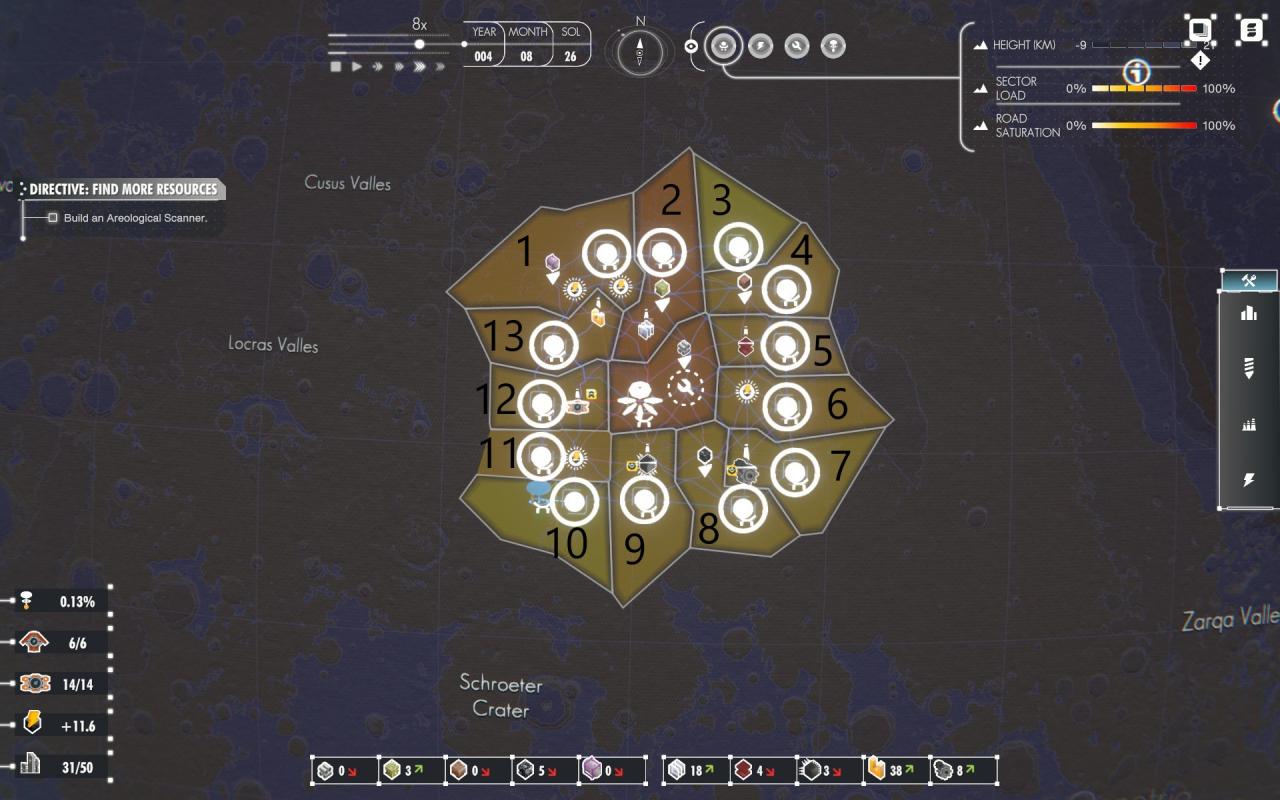 This is the “Worker lens”, accessed by pressing <F1> or selecting the icon immediately to the right of the compass. Its somewhat helpful in troubleshooting logistical problems.
This is the “Worker lens”, accessed by pressing <F1> or selecting the icon immediately to the right of the compass. Its somewhat helpful in troubleshooting logistical problems.
The first thing you’ll notice about the is that all the territories are colored, ranging from yellow (0% “Sector Load”) to red (100% “sector load”). You should completely and totally disregard this information — at best, sector load isn’t harmful, but more often than not, sector load is grossly misleading.
You see, what sector load measures is the percentage of time the drone assigned to this drone hub spends idling in the drone hub. This is a really bad way to measure the performance of your workers. I’ve suggested, and hope to see implemented, an alternate measure of “Queue Length”, which shows the number of items the drone in this territory could be shipping but isn’t for whatever reason (almost always this will be because its busy with another task).
The second thing to note is the territory claimed by each hub. In the screenshot, all drones except three have exactly two buildings within their territory (including the drone hub itself). Drone hub 1 has four buildings (two solar panels and a chemicals mine), hub 3 has only one building (the drone hub itself), and the central hub has three buildings (an aluminium mine, a maintenance tower, and the landing site).
This is a good thing!
Looking at drone #1 (upper left), the drone can do the following useful things:
- First, it can ship chemicals from the chemical mine (inside its territory) to the plastics factory (adjacent to its territory).
- Next, it can ship silicon (adjacent) to the glass factory (also adjacent).
- It can ship plastic produced by the plastics factory (adjacent) to the glass factory (adjacent), getting it closer to its destination (either the maintenance hub or the landing site)
- It can ship glass produced by the glass factory (adjacent) to the worker hub just to the south, moving it closer to its final destination (the worker factory).
Looking at the drone just to the south (#13, whose territory only includes the plastics factory), the following options are available:
- It can ship glass (if delivered by the drone 1, to either its hub or the adjacent solar farm) to deliver to the worker factory (adjacent)
- It can ship plastic (inside) and deliver it to the landing site (adjacent! Really — there is a road connecting the drone hub directly to the landing site, so its adjacent!)
- It can ship chemicals from the chemical mine (adjacent — again, there is a direct road between, so its adjacent) and deliver it to the plastics factory
As you should see by this point, a large number of drone hubs produces more potential paths to ship goods than a casual glance at the territory map would indicate. With so many paths available to the game, the odds that a good will remain “stuck” in an output bin (leading to production stalls) is quite low, and the odds that goods will be delivered “on time” to their destinations will help eliminate input stalls.
Logistics troubleshooting
There are four types of logistics failures that you may run into:
- Insufficient demand
- Insufficient supply
- Logistics bottlenecks
- Bugs
Insufficient demand
Insufficient demand exists when a source of supply:
- Has 6/6 in its output
- Has no silvery grey lines leading from it
Note: This is a common source for the complaint “My factories don’t have any resources, but my drones are doing anything — its a bug!”
Example:
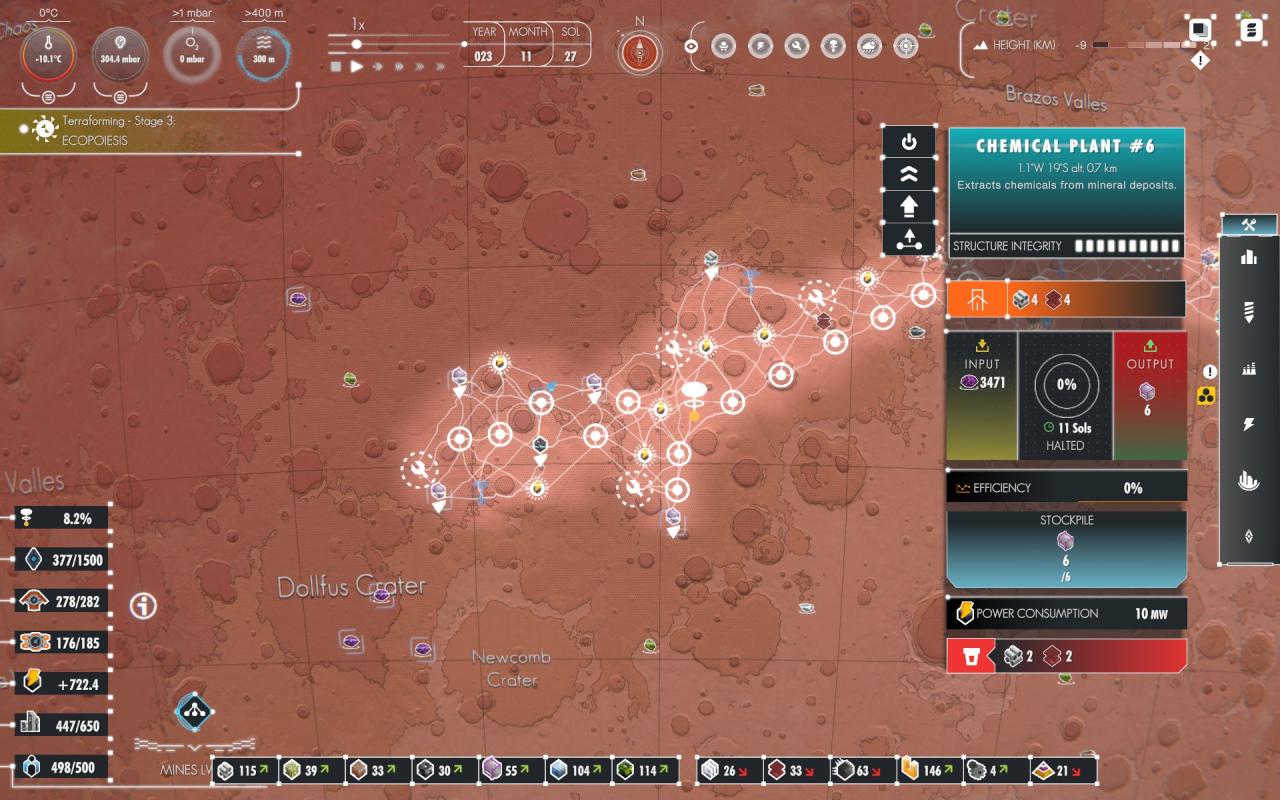 The reason that this Chemical Plant is suffering from an output stall (6/6 in its “Output” stopping production) is that all existing demand is being fulfilled from other (closer to the demand source in this case) sources.
The reason that this Chemical Plant is suffering from an output stall (6/6 in its “Output” stopping production) is that all existing demand is being fulfilled from other (closer to the demand source in this case) sources.
To fix this problem you must create additional demand — building a new food factory, for example. Note that doing so will likely reduce your production rate (e.g. “90%”), but may increase your gross production.
But probably not — more often than not, when you actually go looking for this sort of problem, the underlying issue is a bottleneck to your existing factories, and adding more resources to the pipeline will simply aggervate your existing bottleneck. Locate the bottleneck and fix that by… Building more worker hubs! 🙂
Insufficient supply
Insufficient supply exists when
- A demand source doesn’t have a full set of inputs
- When clicked on, there are no silvery grey lines extending from the demand source (alternatively, there are silvery grey lines — but the total goods that they point to doesn’t add up to the expected demand)
Example:
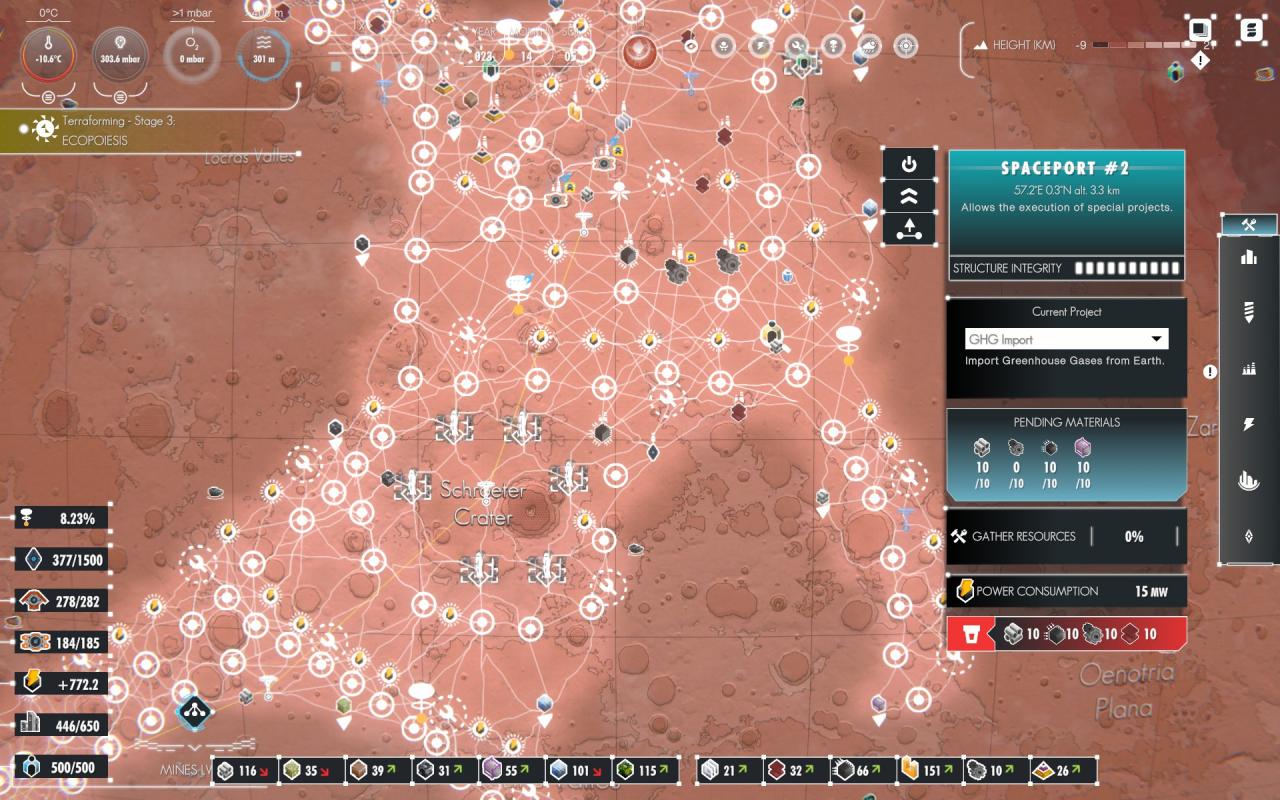
This Spaceport (“Spaceport #2”) is demanding parts (gear icon), but no parts are available. Note that there are parts available on the map (10, to be exact), but some combination of the following are true:
- The parts are at another job site
- The parts are traveling to another job site
In this case, 2 parts are at worker factories (both are prioritized, so their demand trumps the demand from the non-prioritized spaceport), and the remainder are at various Hyperloop construction sites (one each). Note that, barring the use of priority, the AI will generally distribute resources evenly across all sources of demand. When supply is very limited, this will result in a large number of sites that have some of what they need, but not all, and progress is very slow.
To fix this problem:
- Ensure that your existing sources of supply are working at high efficiency. If they aren’t you need to troubleshoot that first.
- Build additional supply, if that is possible (if your shortages is of, say, water, then this may not be an option).
- Eliminate some of the sources of demand — you can use the power button to turn off anything, including construction sites. This will cause any resources at that location to be released for redistribution as well, which may also help.
- Designate one of the sources of demand with the priority flag — this will ensure that the limited supply is concentrated in a single location, where it can actually do some good.
As of Patch #3, there is a bug that makes limited supply more serious — see the bug section for more details.
Bottlenecks
The symptoms of a logistics bottleneck are:
- When clicking on the resource consumer, there is one silvery grey line for each missing input. See below for an example.
- One (or more) of the nodes pointed to by the silvery grey lines contains more than 1 or 2 resources.
Practical example:
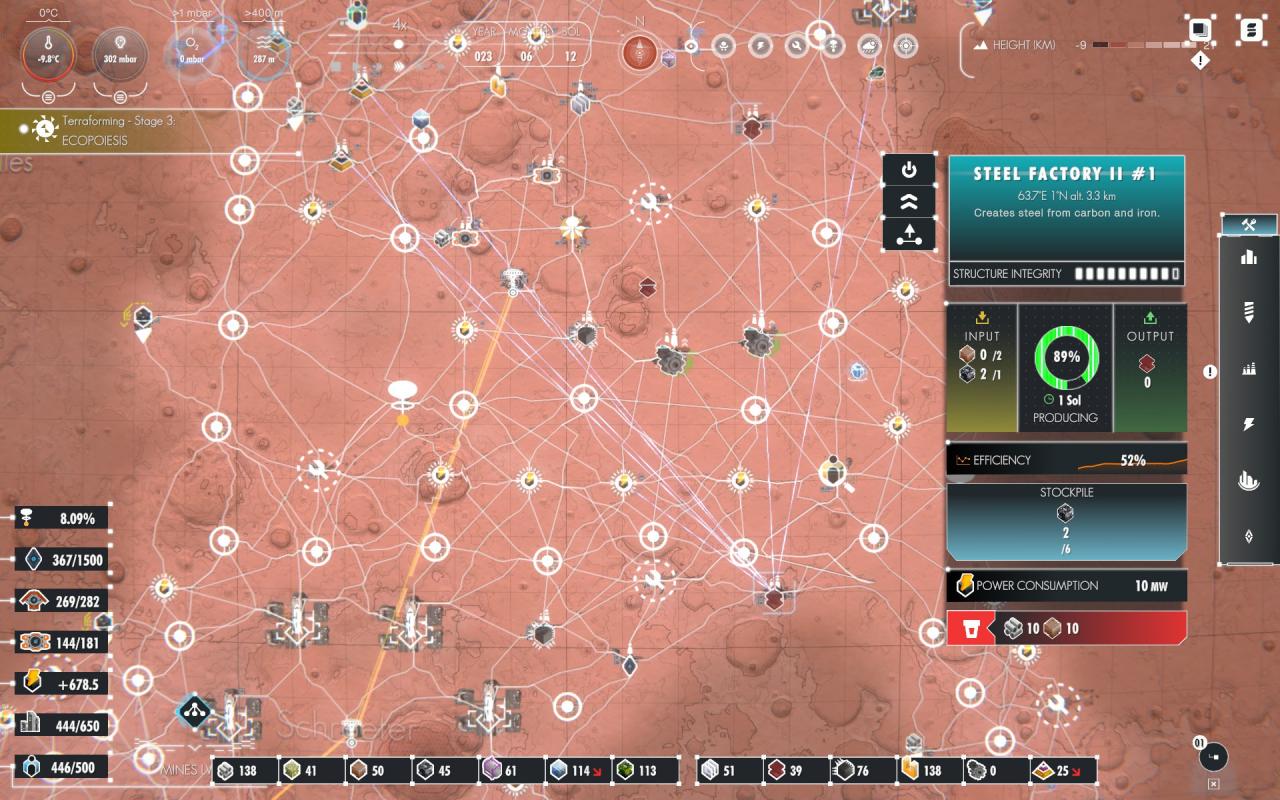 The steel factory in question should be generating demand for 16 items — 12 iron, and 4 carbon.
The steel factory in question should be generating demand for 16 items — 12 iron, and 4 carbon.
Checking these lines out one at a time reveals:
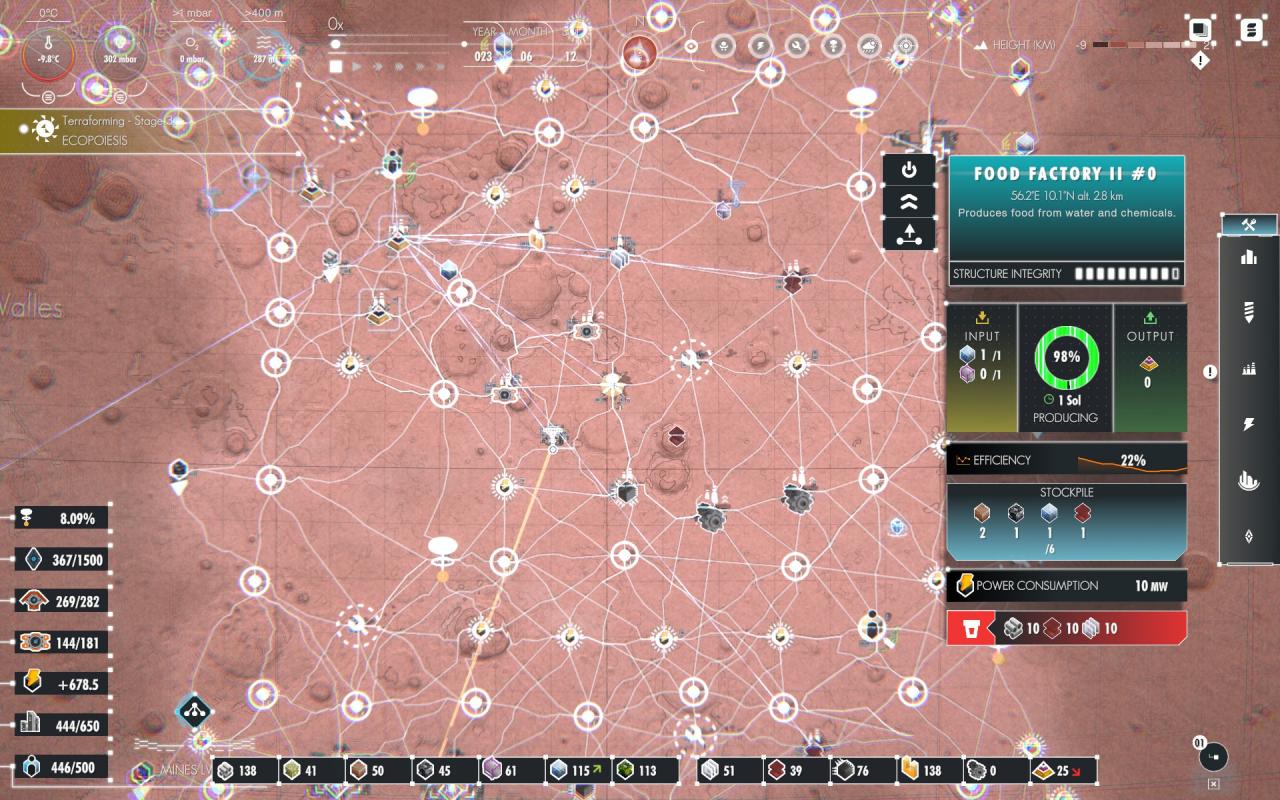 2 iron and 1 carbon in this node.
2 iron and 1 carbon in this node.
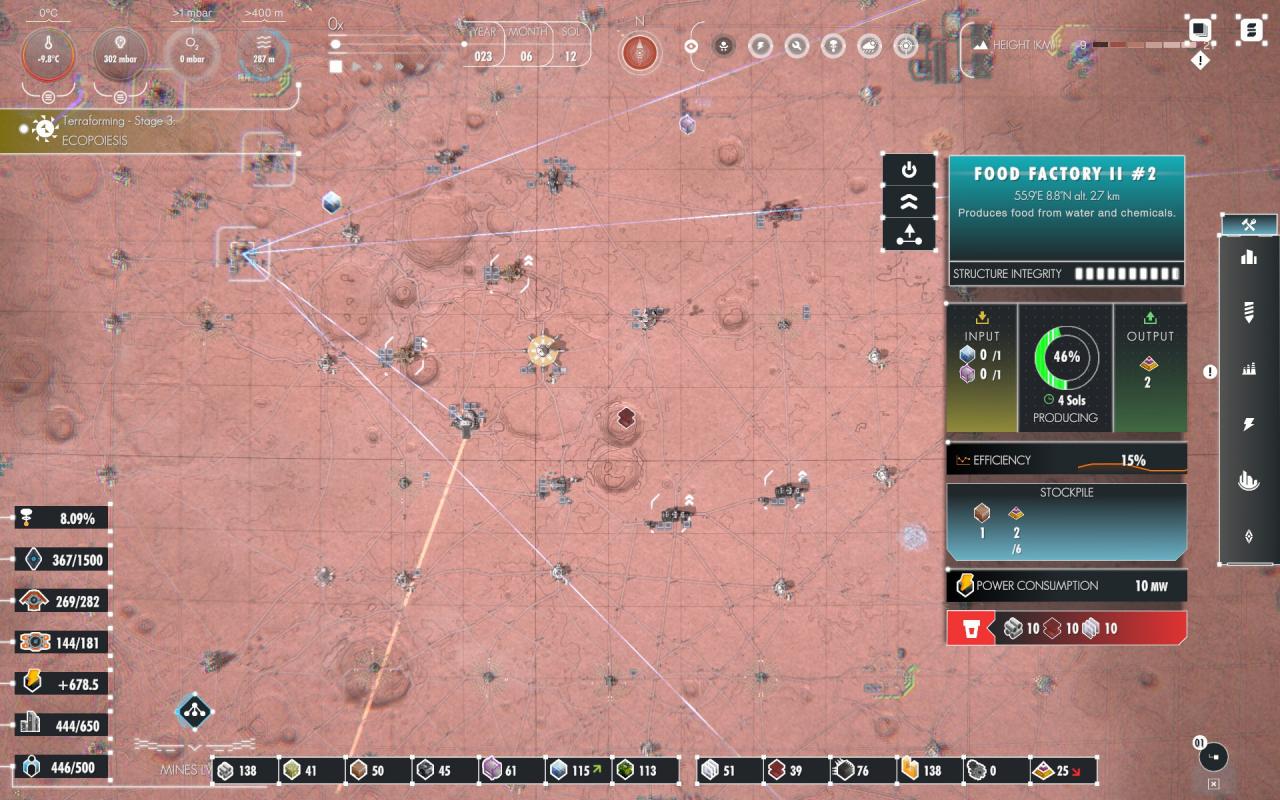 1 Iron in this node
1 Iron in this node
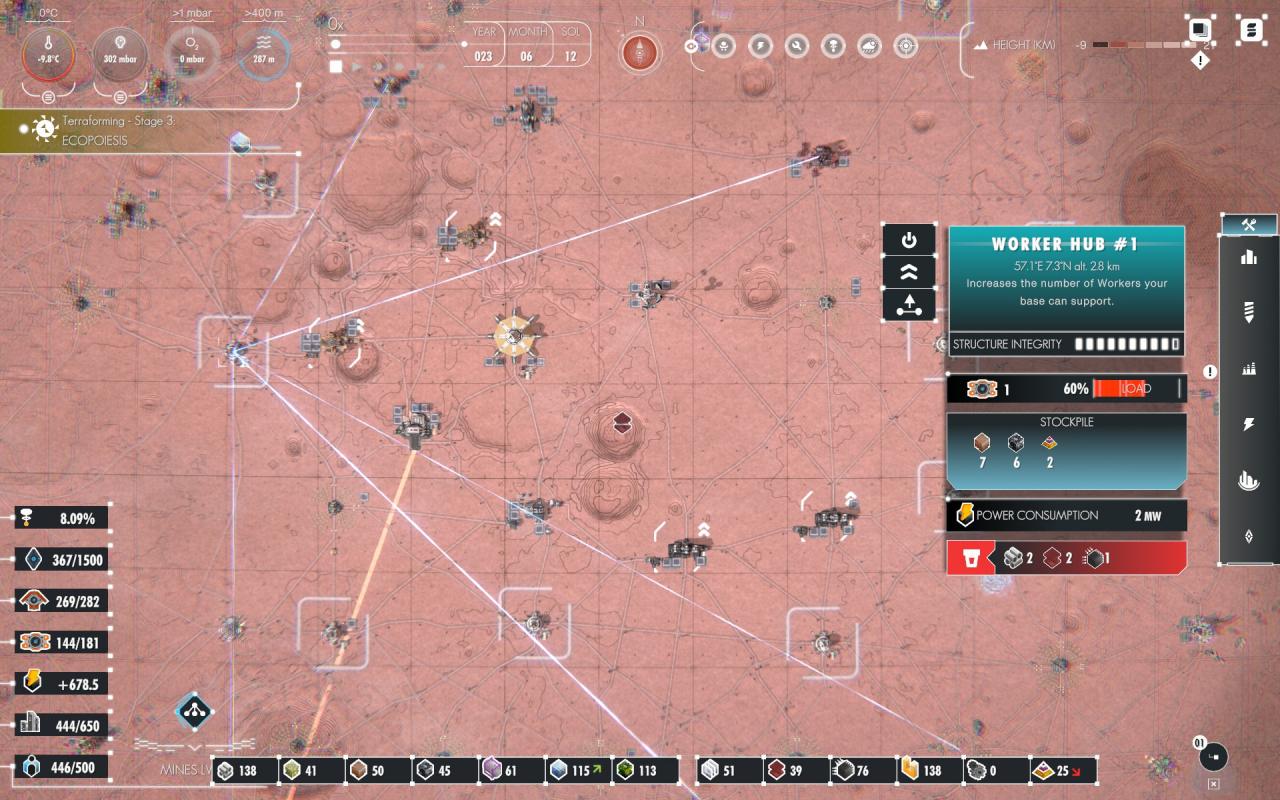 7 iron and 6 carbon in this node
7 iron and 6 carbon in this node
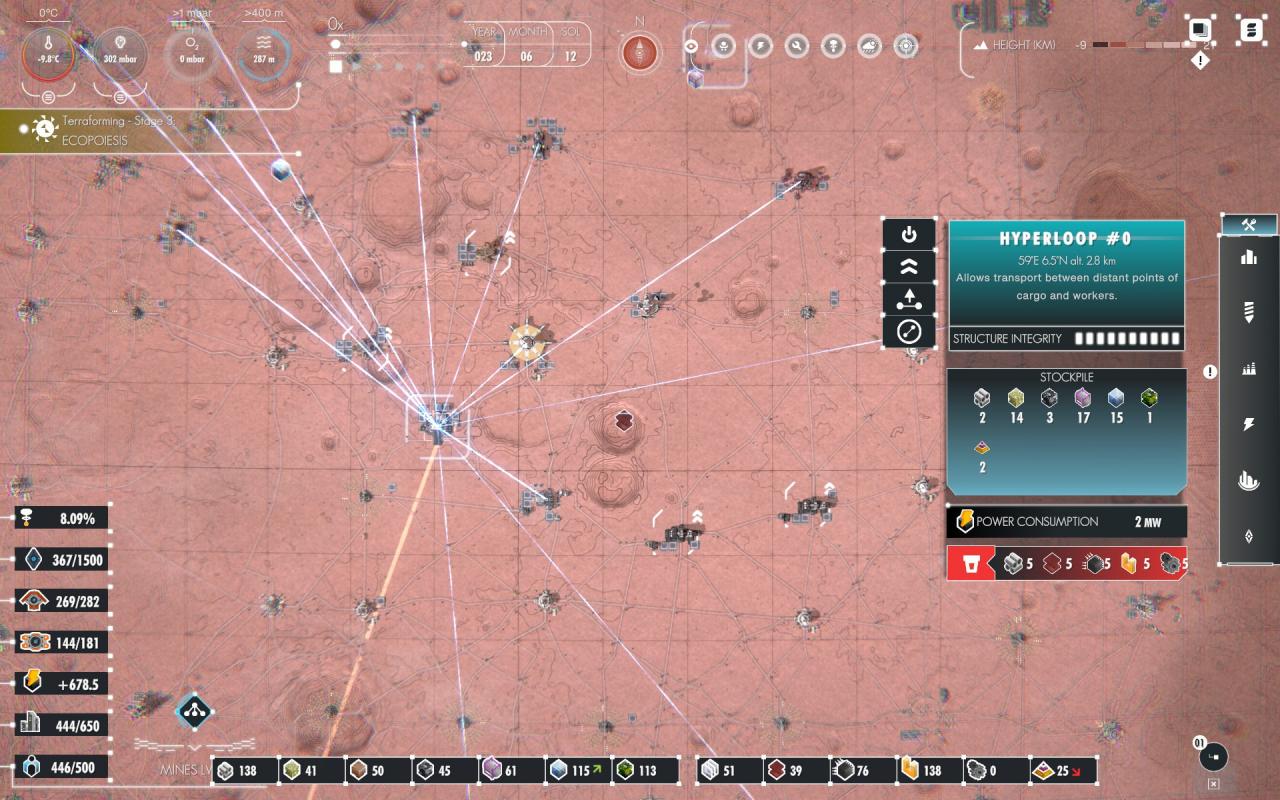 3 carbon in this node
3 carbon in this node
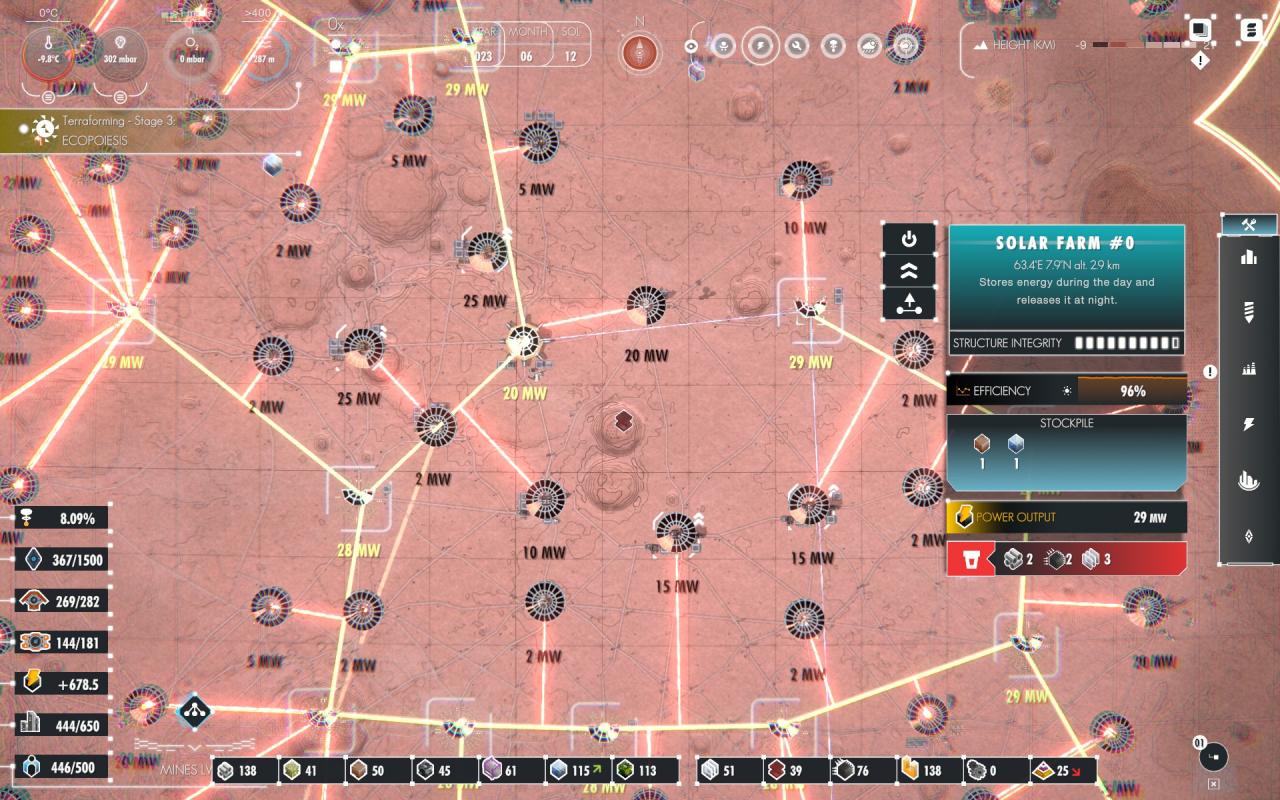 1 iron in this node
1 iron in this node
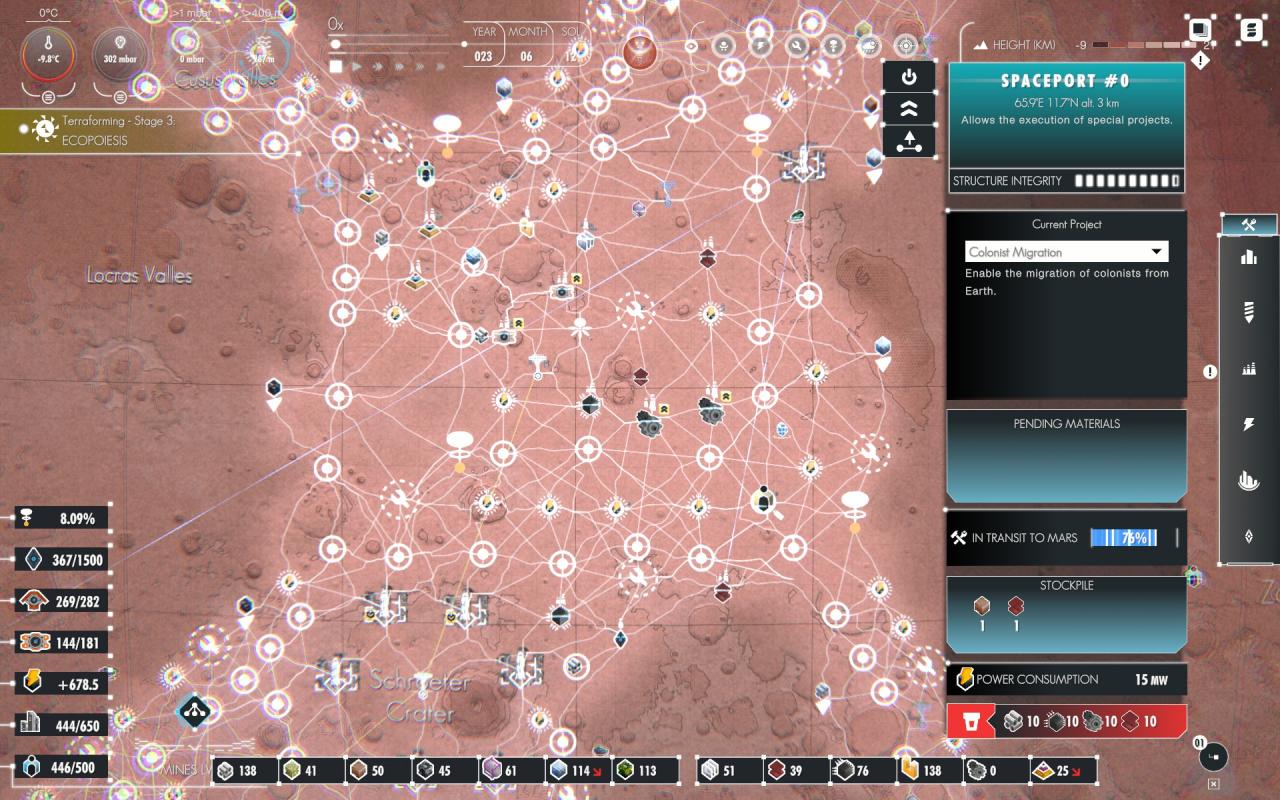
Adding this all together, we have 12 iron and 4 carbon — exactly as expected. Sometimes you will find extra resources (e.g. you expected 12 iron and 4 carbon, but found 16 iron and 8 carbon). In this case, you need to check other sources of demand (another steel factory in this example), as resources demanded by the other demand sources may be coincidentally be occupying the same node.
The primary problem is clearly the third node on the list — almost half of the iron and carbon destined for this steel factory is “stuck” in this node. Switching to the worker lens and allowing time to proceed reveals…
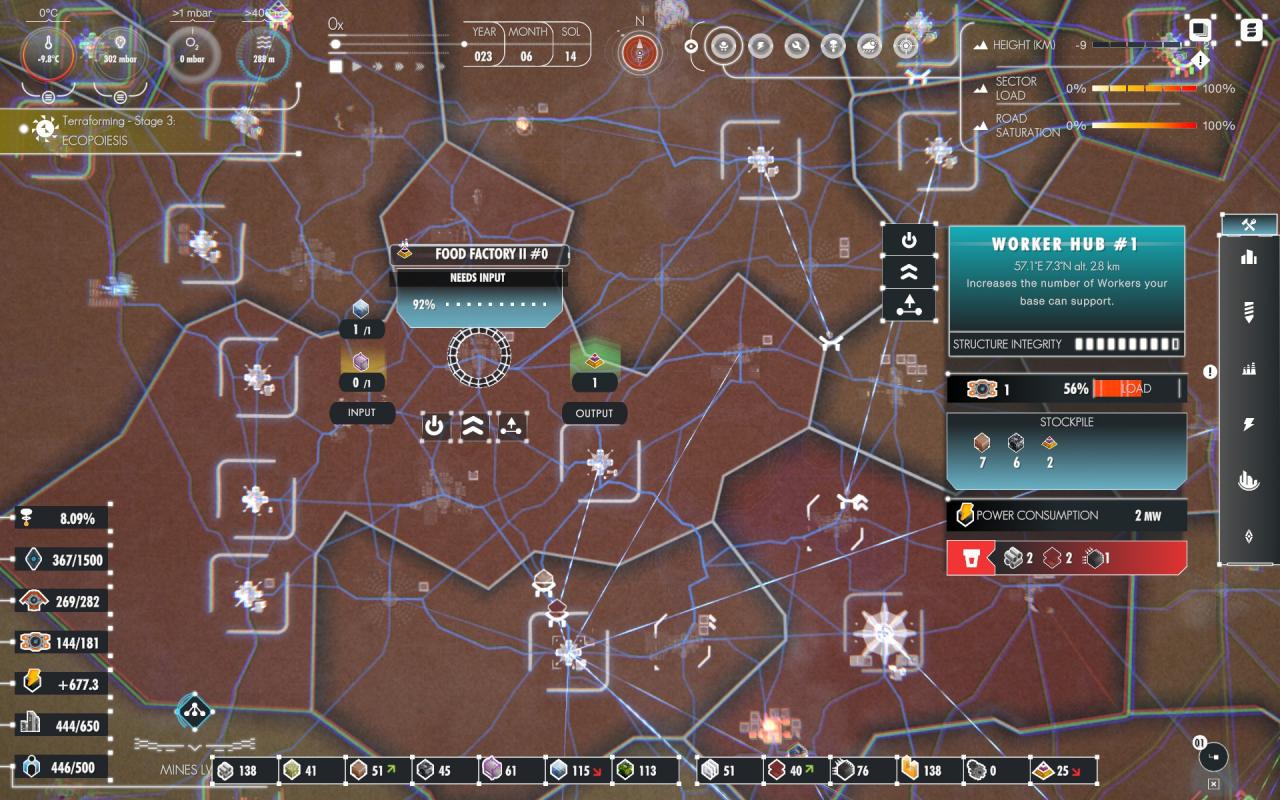 Part of the problem is that this node (“Food Factory II #0”) is considered adjacent to this node (it has a direct road connection) but is quite distant — the worker is making long trips between these two nodes, slowing throughput.
Part of the problem is that this node (“Food Factory II #0”) is considered adjacent to this node (it has a direct road connection) but is quite distant — the worker is making long trips between these two nodes, slowing throughput.
Next, this node is adjacent to the hyperloop. While a hyperloop doesn’t demand resources in the sense that a factory does, it serves as a destination and source for a large amount of resources.
Finally, the fact that this node is adjacent to two different worker factories, both marked with priority flags (one in territory, one adjacent to the east) is another issue — goods destined to a prioritized destination always get moved first, regardless of how long other goods have been waiting.
My recommendation here is twofold:
- First, add a new drone hub to block the long connection to the food factory. If the drone never takes this long trip, things will be much better.
- Second, add a drone hub to the south, adjacent to the solar farm. The new node will be adjacent to this node but not adjacent to the worker factory (make sure there is no road between this node and the worker factory!), so it will be free to pickup and move goods towards the steel factory
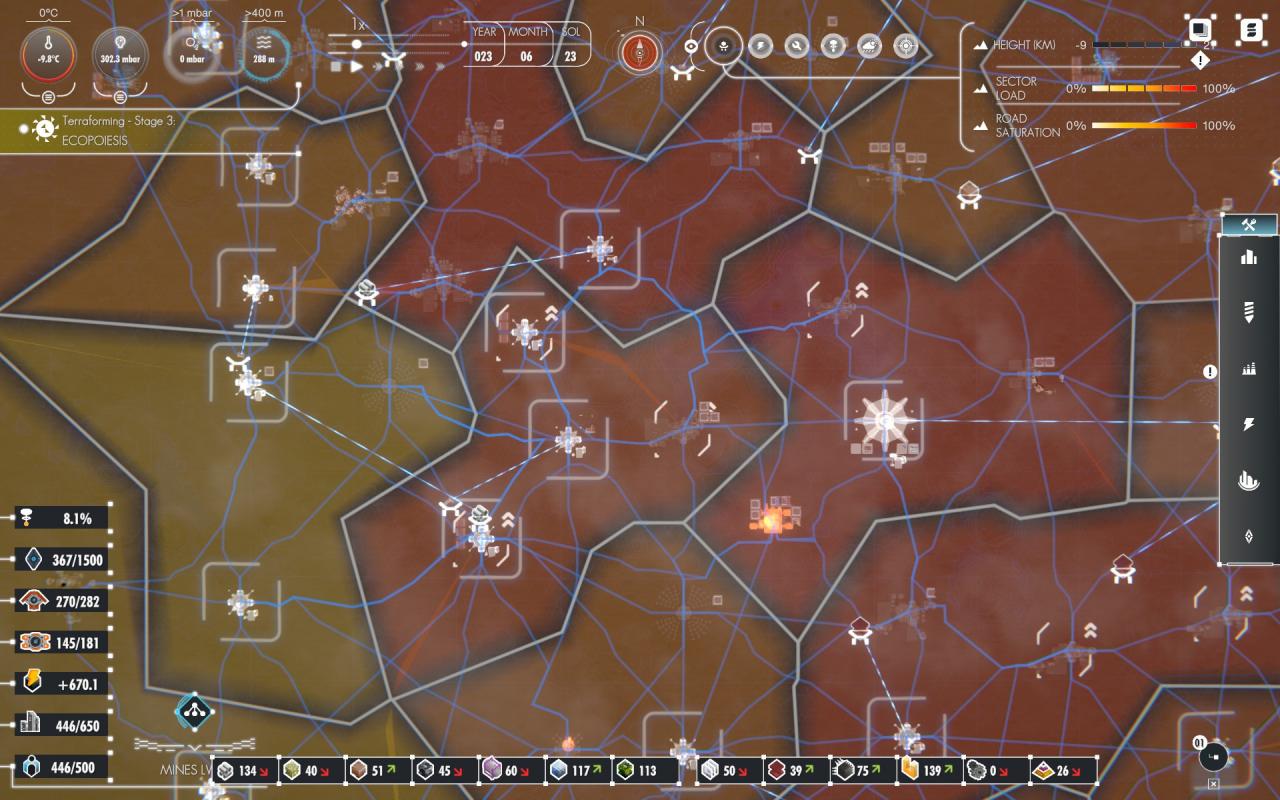 The new nodes are scheduled for construction. Note that adding the node to block adjacency for the food factory immediately improves matters somewhat, as it blocks access to the food factory.
The new nodes are scheduled for construction. Note that adding the node to block adjacency for the food factory immediately improves matters somewhat, as it blocks access to the food factory.
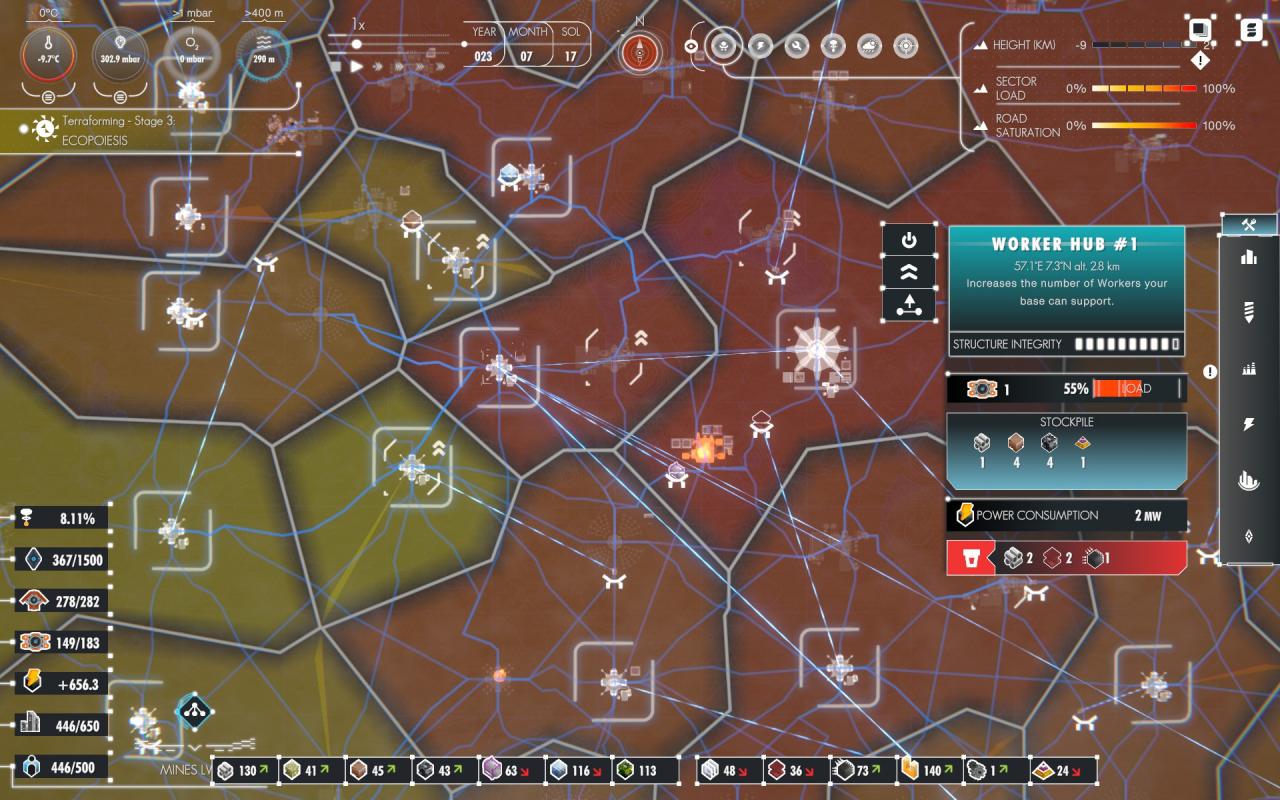 Immediately after the two new worker hubs are completed and staffed
Immediately after the two new worker hubs are completed and staffed
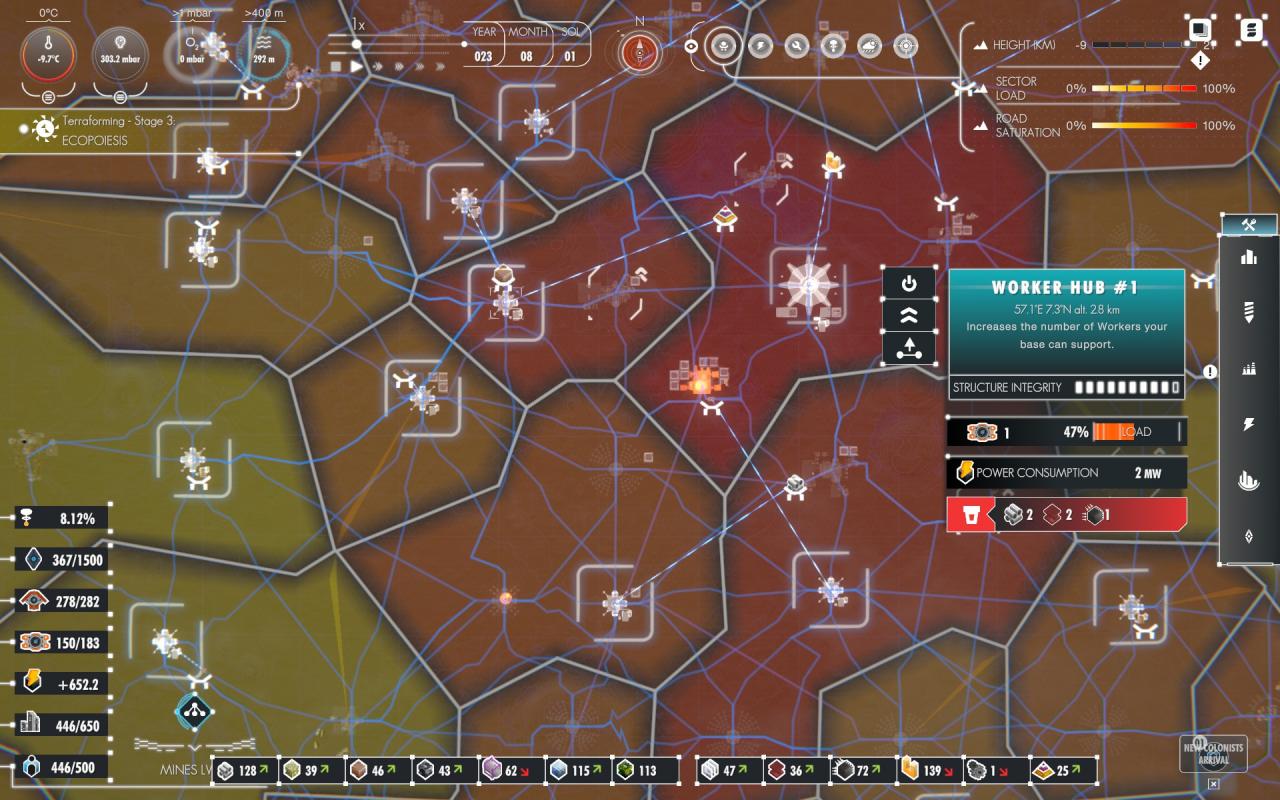 Fixed — the bottleneck is cleared!
Fixed — the bottleneck is cleared!
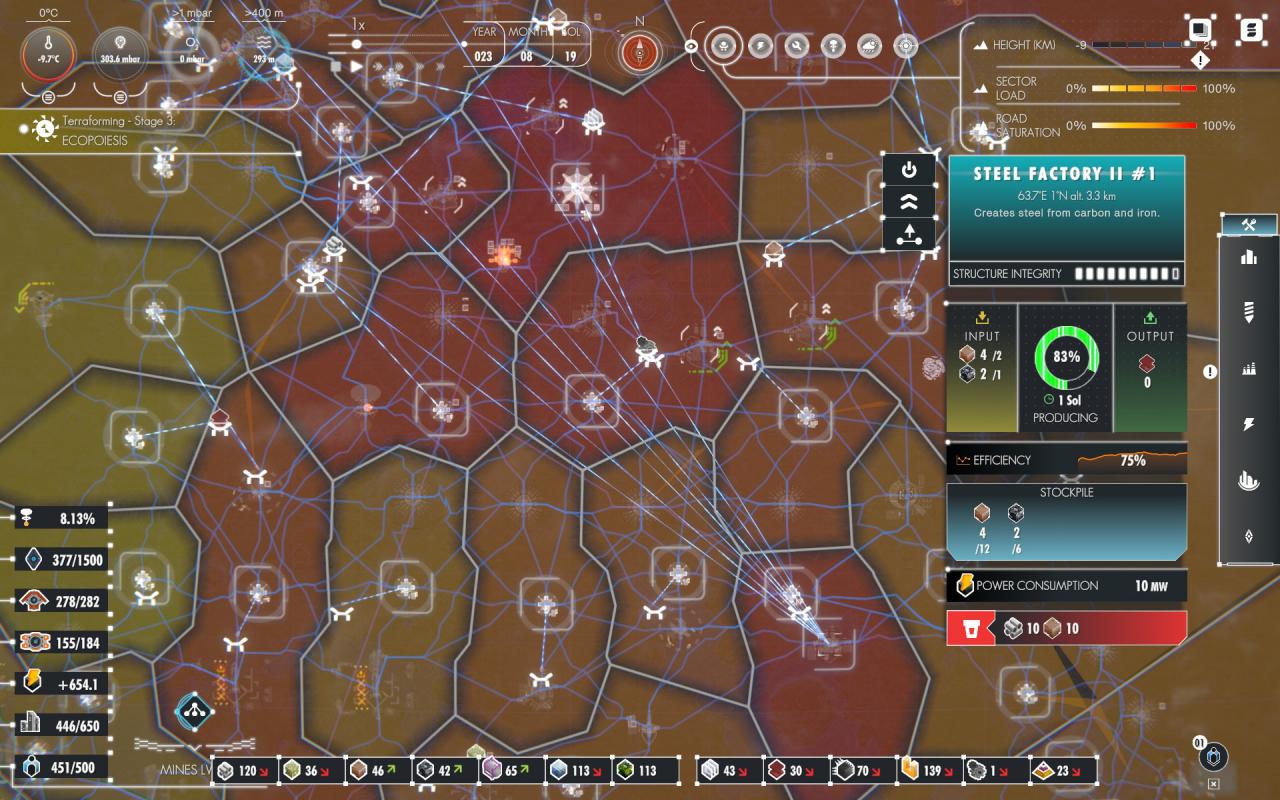 Production is up dramatically at the factory.
Production is up dramatically at the factory.
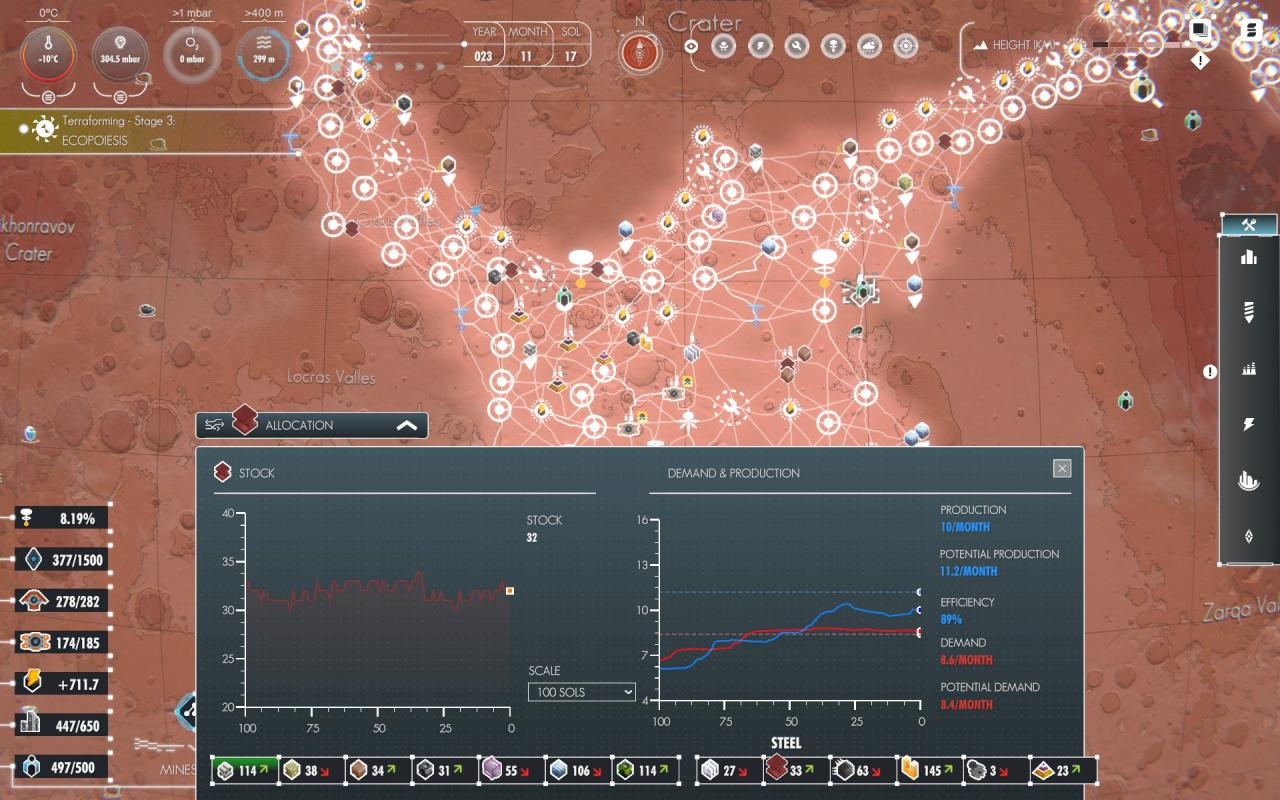 A bit later and the impact on overall production is obvious.
A bit later and the impact on overall production is obvious.
Yes, this is a time consuming process — but this is how the game is supposed to work. You can limit the number of times you have to go through this involved troubleshooting process by… Building lots of worker hubs. 🙂
Seriously, the more worker hubs you have the less likely problems like this are to occur, simply by virtue of having a large amount of drones available.
Bugs
As of patch 3, I am aware of two bugs that impact logistics:
- Resources, almost always travelling via hyperloop, will start “bouncing” between two nodes, making no progress.
- Resources that have arrived at their final destination are subject to being re-dispatched to another location.
The first bug is by far the most serious — a good caught in a cycle like this counts as “in transit” for the demand source, yet never arrives. With large scale projects, especially late game space missions, the odds of at least one good getting caught in a cycle like this is nearly 100%, and it stalls progress indefinitely. To fix this problem:
- About 90% of the time, turning off both the hyperloop terminals that are involved in the “bouncing” will solve the problem — in ~2-3 in game months.
- Turning off, then back on, the source of the demand will always fix the problem immediately.
Because of this first bug, the developers released patch #3 which… Automatically toggles (in the background) long-running sources of demand, mostly impacting construction sites and spaceports.
The good news is that it ensures that large projects eventually finish.
The bad news is that it created the second bug listed above — when you toggle a demand source like that, it recalculates its sources of supply from scratch. This means that it will see any stationary goods as valid sources to satisfy its demand — which includes goods sitting at construction sites. Ooops.
The second bug can be worked around by setting the priority flag on one construction site, letting it complete, then moving the priority flag to another construction site. Alternatively, you can limit yourself to one active construction site at time.
The second bug is less serious if all the construction is occurring in the same area (while the “shuffling” occurs, the goods don’t have as far to travel), when the construction is inexpensive (drone hubs vs. scanners, for example), and when supply is abundant (there isn’t time for the shuffle to occur).
Walkthrough Introduction
Unmarked spoilers after this point — do not proceed if you don’t want to be spoiled!
The walkthrough that follows is not the only way to defeat the first enemy base — it isn’t even the best by my own standards. The strategy I employed is designed to show that the “build lots of drone hubs” strategy is effective, and along the way provide a guide to overcoming one (of two) major challenges in the game.
Some obvious optimizations to the strategy shown include:
- Build slightly fewer drone hubs, especially in the long spurs leading off to resources. Really, you could get by with about half as many. That’s still far more than most players build, in my experience.
- Perhaps build some storage? I deliberately didn’t build storage (didn’t even research it) because storage makes logistics problems harder to troubleshoot. The rules for when storage generates demand (it seems to be distance based) and how the AI decides which storage will get an item is unclear to me, so I just skipped it altogether. It would be very, very helpful to have some storage with electronics in it before the first sneak attack, though.
- Using nuclear weapons to free up the CO2 in the ice caps is, by far, the slowest way to finish the first terraforming stage. Anything else is faster, if that’s a priority.
I also didn’t deploy a second landing site to explore the nuclear silo (in SA-9). I’m dubious as to whether deploying a landing site like this is a net time savings on any level — to actually explore the nuclear silo, you’ll need to setup a fully functioning economy using the resources patches that spawn in when you drop the lander, then build the research post. By the time that I unlocked SA-9 (the earliest you could deploy the launch site) my spur was fairly close to the site anyway, so… Beyond that, you’ll eventually want to connect the two bases (to share resources and power), so you’ll have to build the spur anyway.
Is it worthwhile? My feeling is no, and I don’t like the free resource patches that spawn with a new landing site, so I don’t use them. Your mileage may vary, and I certainly understand their value when the Random Number Gods decide they hate you with random resource spawns.
With all that said, on to the walkthrough.
Walkthrough part 1
 The starting position, with the tutorial not yet completed.
The starting position, with the tutorial not yet completed.
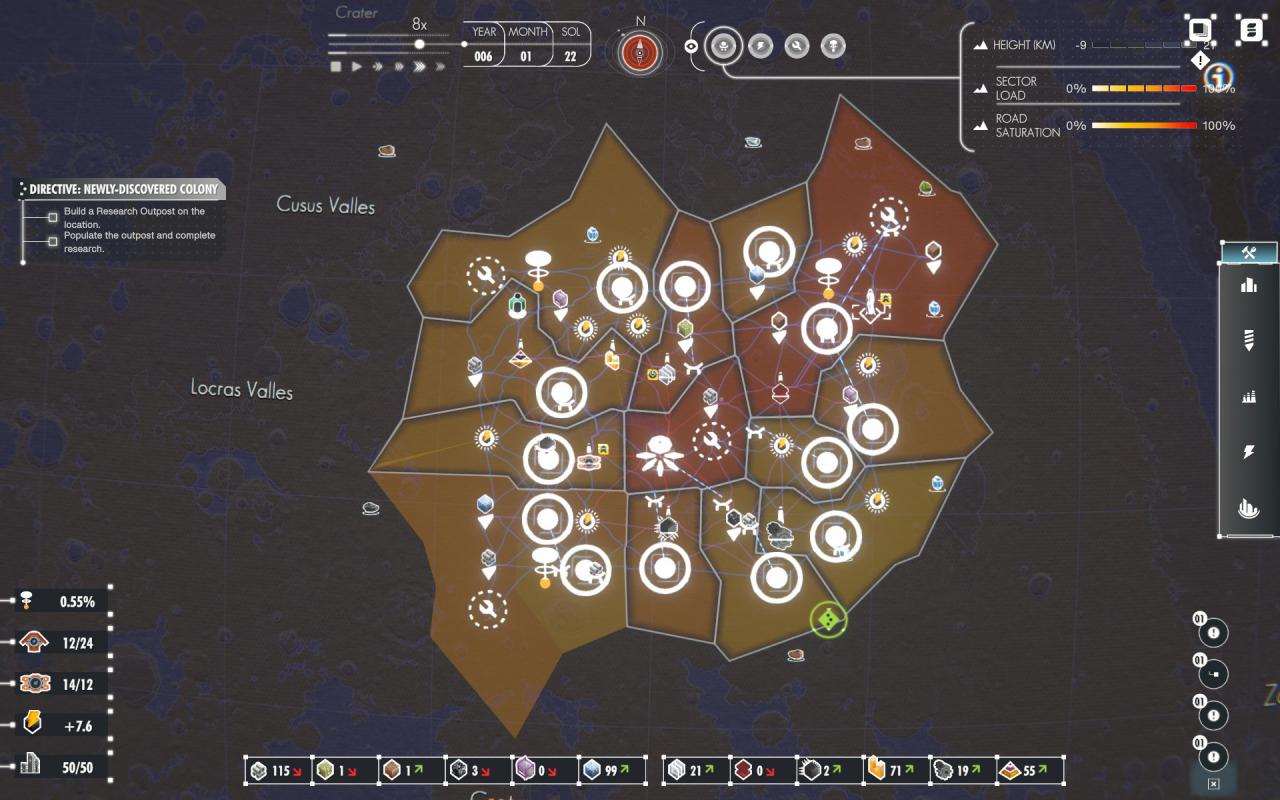 I built a couple of Areological Scanners (henceforth simply “scanners”), exploited the resources that they discovered, and waited patiently for colonists to arrive to increase my building limit:
I built a couple of Areological Scanners (henceforth simply “scanners”), exploited the resources that they discovered, and waited patiently for colonists to arrive to increase my building limit:
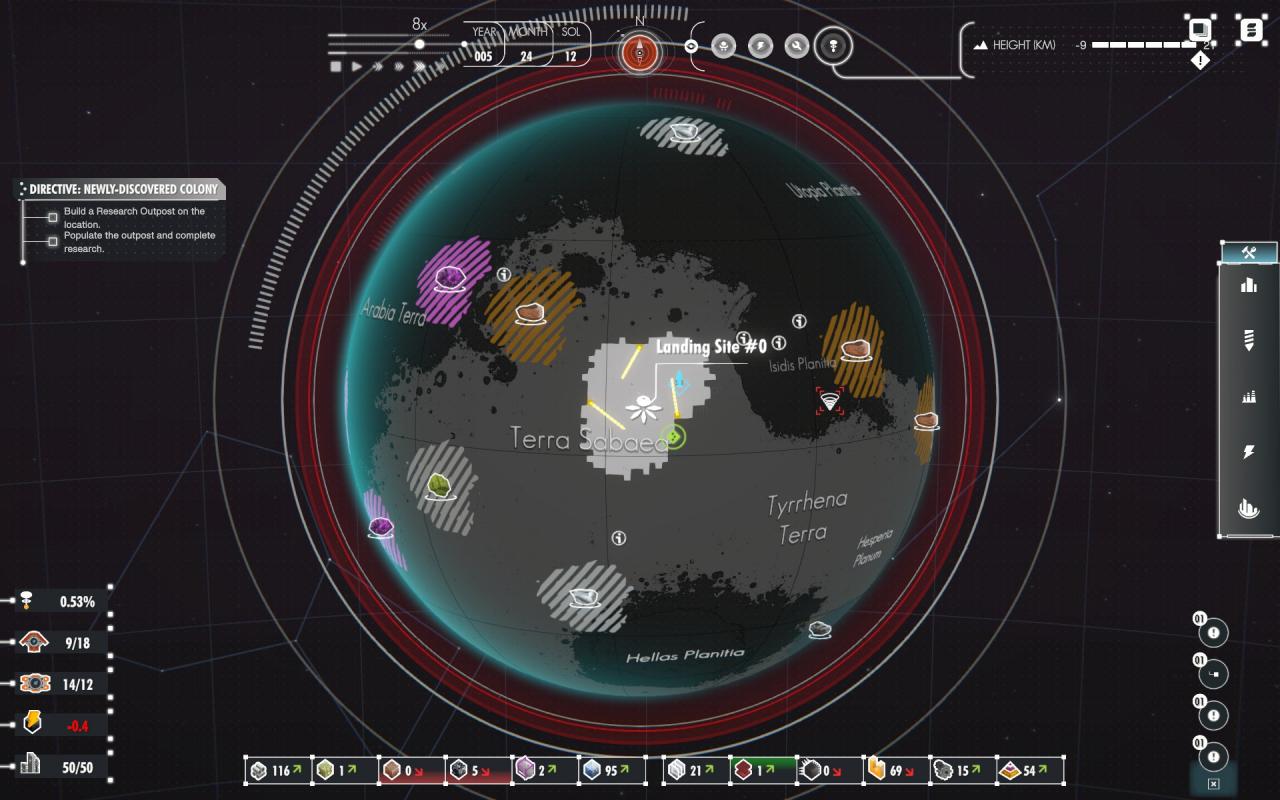 While waiting for the colonists to arrive it is time to decide where to expand to next:
While waiting for the colonists to arrive it is time to decide where to expand to next:
Given that this isn’t my first game, I recognized that:
- First, I’d want to expand to the southwest, because there is a mission objective there and
- Second, I hadn’t located any other deposits of silicon, which is required for to produce “Electrical Parts”, which is critical to the production of maintenance drones (and many other things) which is a critical need in the future.
Made the choice easy — I needed to expand toward the silicon patch located to the southwest.
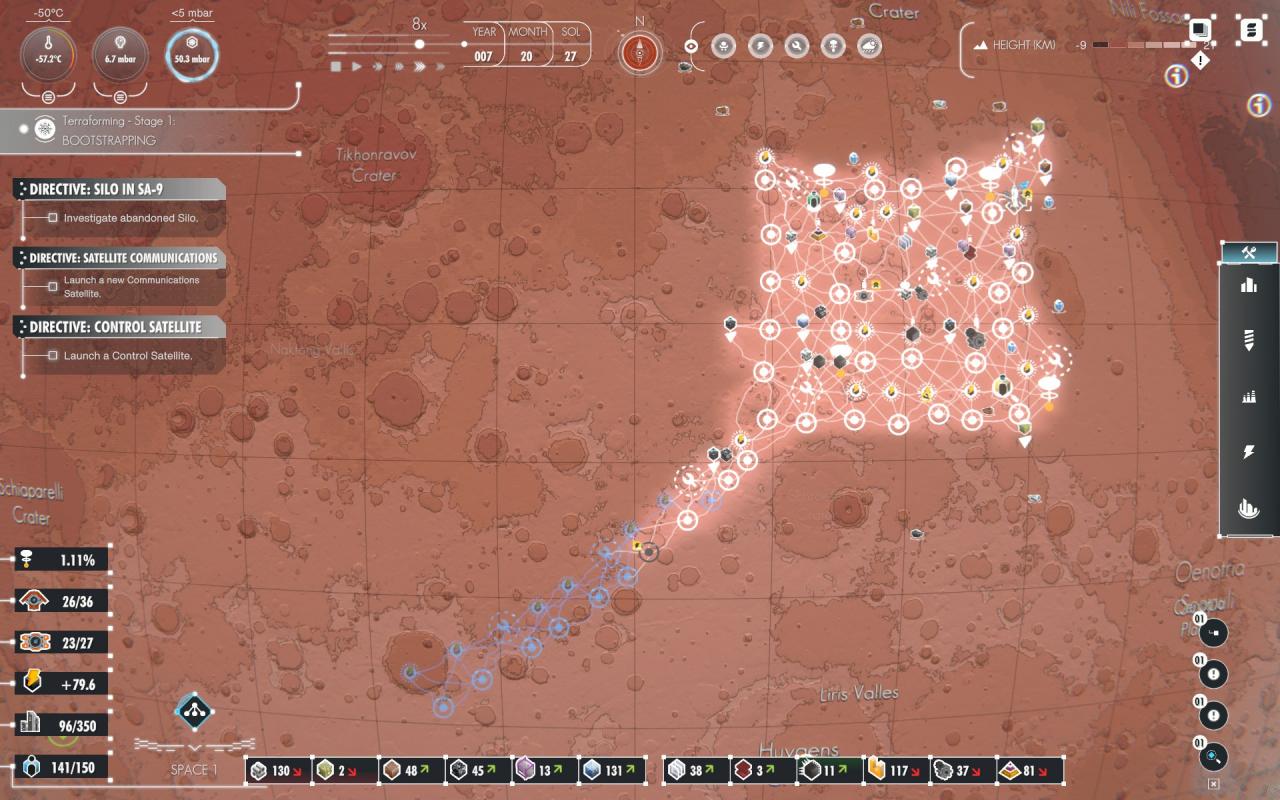 At the time of this screenshot, I had already researched the first two “basic” engineering techs, simply to increase my building limit, and was working on researching the first “basic” space tech, to allow me to build two new spaceports (I hate turning off the “Import Colonists” mission, so I wasn’t interested in launching the SA-9 satellite until I had a second spaceport built).
At the time of this screenshot, I had already researched the first two “basic” engineering techs, simply to increase my building limit, and was working on researching the first “basic” space tech, to allow me to build two new spaceports (I hate turning off the “Import Colonists” mission, so I wasn’t interested in launching the SA-9 satellite until I had a second spaceport built).
 Two years later, and new construction was getting close to SA-9,
Two years later, and new construction was getting close to SA-9,
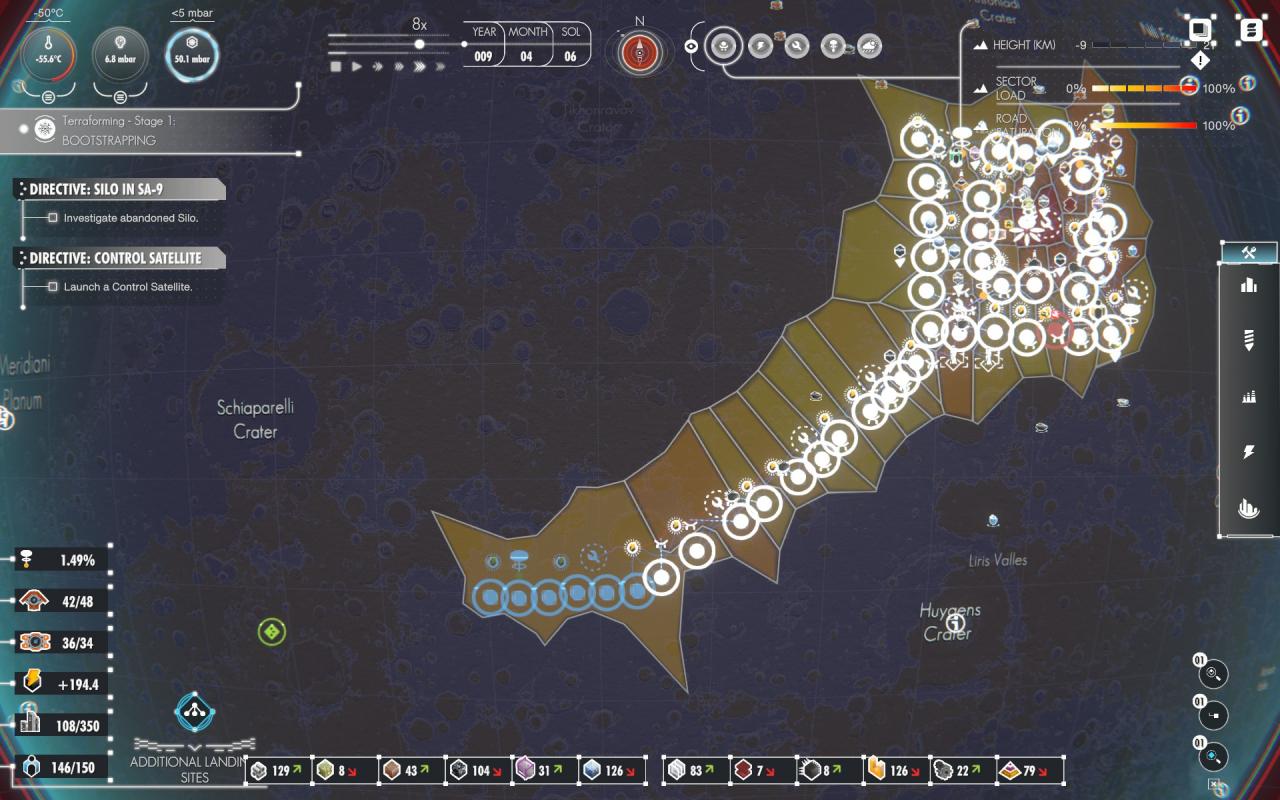 Boy, that’s a lot of drones, isn’t it?
Boy, that’s a lot of drones, isn’t it?
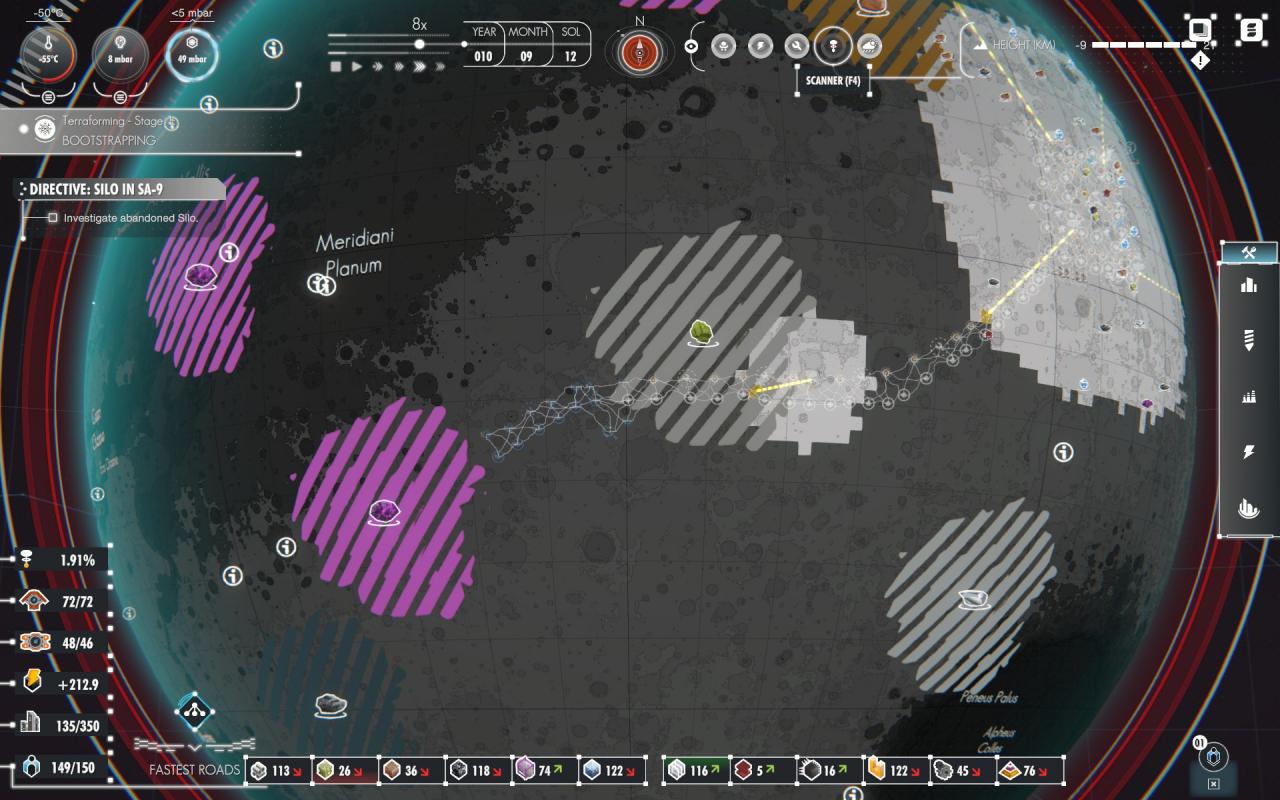 In year 10, I unlocked SA-9, built the the scanner to search the silicon patch, and planned further construction into SA-9 to both reach the chemical patch and get access to the POI for the nuclear weapons.
In year 10, I unlocked SA-9, built the the scanner to search the silicon patch, and planned further construction into SA-9 to both reach the chemical patch and get access to the POI for the nuclear weapons.
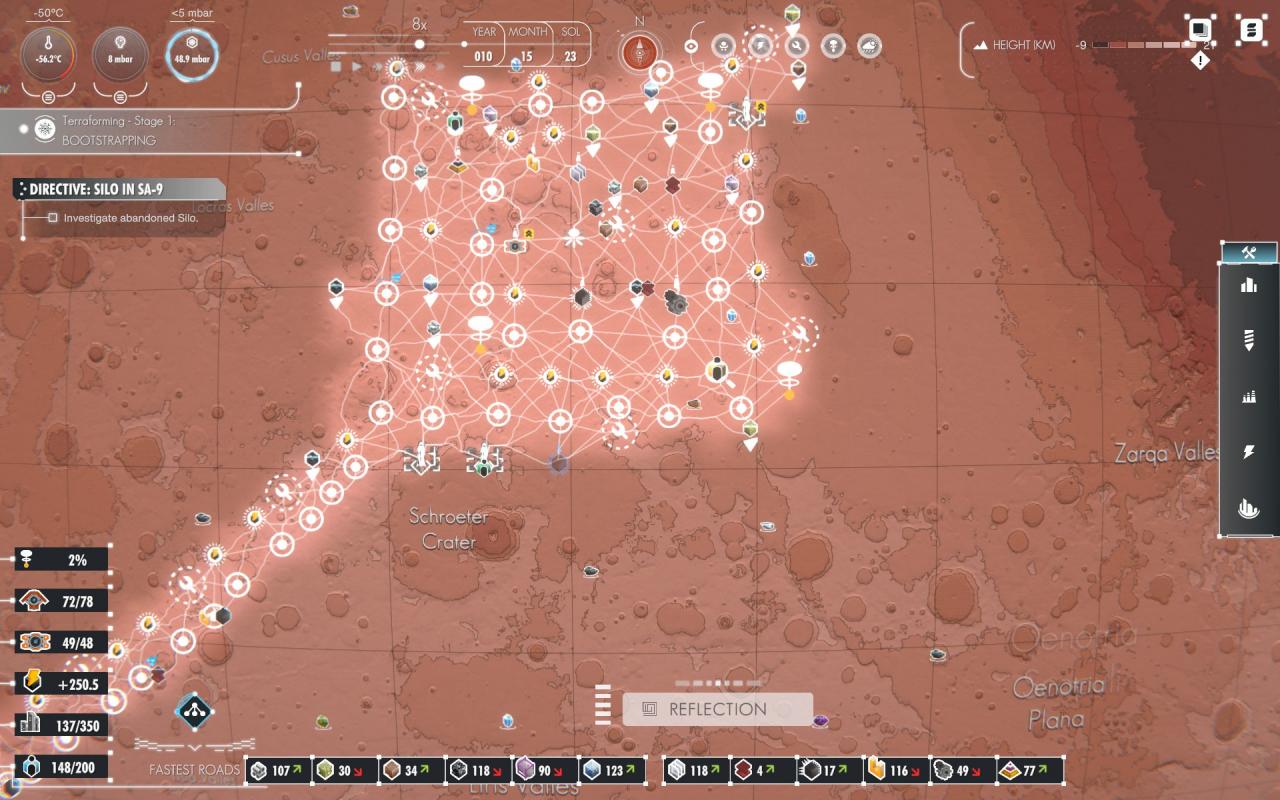 A close up of my base — note that the only additions to my base are some mines, two spaceports, and one basic colony. In particular, I haven’t built any additional factories at this time. Why? Because it is much easier to keep a single factory running at 100% efficiency, and as long as one factory is enough… Why build two?
A close up of my base — note that the only additions to my base are some mines, two spaceports, and one basic colony. In particular, I haven’t built any additional factories at this time. Why? Because it is much easier to keep a single factory running at 100% efficiency, and as long as one factory is enough… Why build two?
If you were wondering: Researching the abandoned silo unlocks the ability to find and mine uranium. It does not guarantee that you will find uranium to mine, and without uranium you can’t use the microsuns. Thankfully, the Random Number Gods were merciful, and a Uranium patch is within reach.
 A year later, and the research outpost has been created (nuclear weapons!) and spurs have been built off of my major highway to reach aluminum and uranium.
A year later, and the research outpost has been created (nuclear weapons!) and spurs have been built off of my major highway to reach aluminum and uranium.
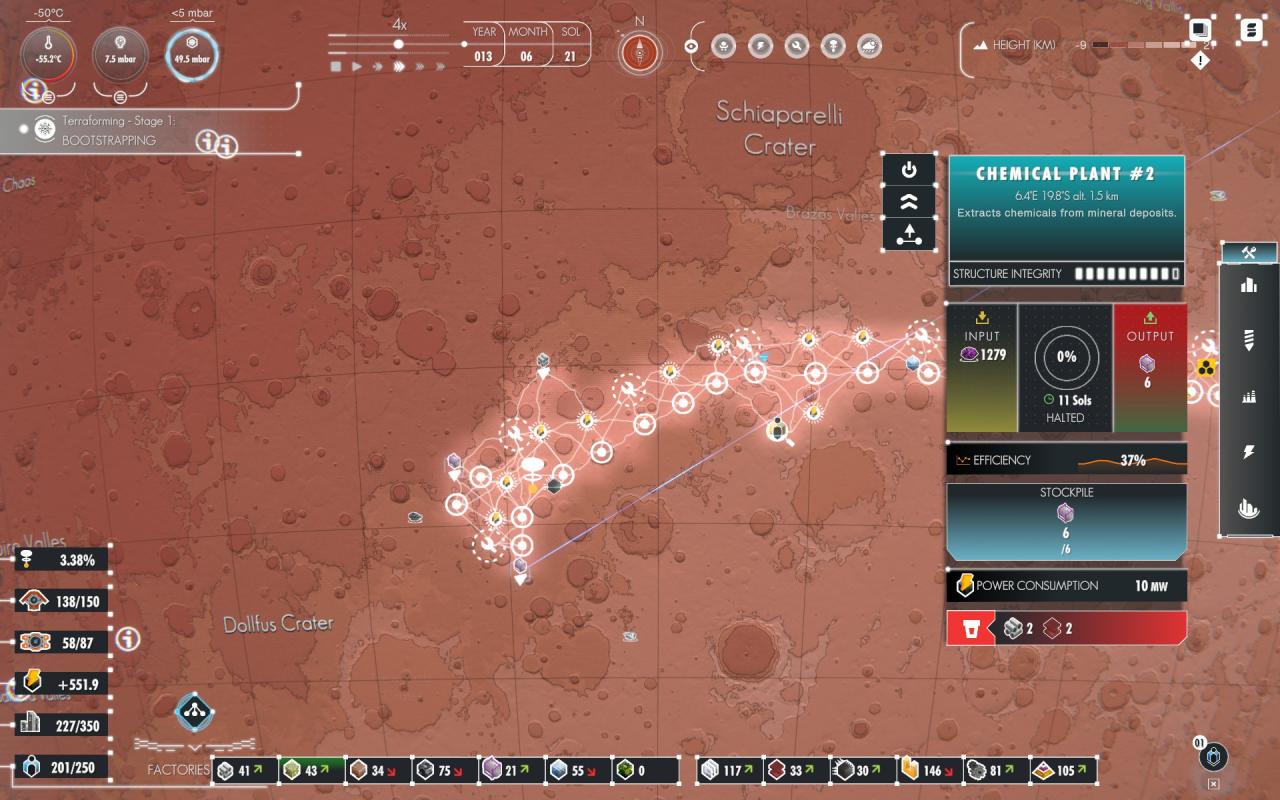 In year 13 my food factories started exhibiting production problems (production efficiency less than 90%), so I investigated the problem.
In year 13 my food factories started exhibiting production problems (production efficiency less than 90%), so I investigated the problem.
An output stall. Note that the silvery line that leads off to the upper right is critical to troubleshooting this problem — the line indicates that at least one of the goods at this location has been assigned to be shipped to another node (the other node can be found at the end of the silvery line — in this case, it leads to a food factory). If the line wasn’t present, then the issue would be lack of demand, in which case I’d need to look elsewhere for the problem.
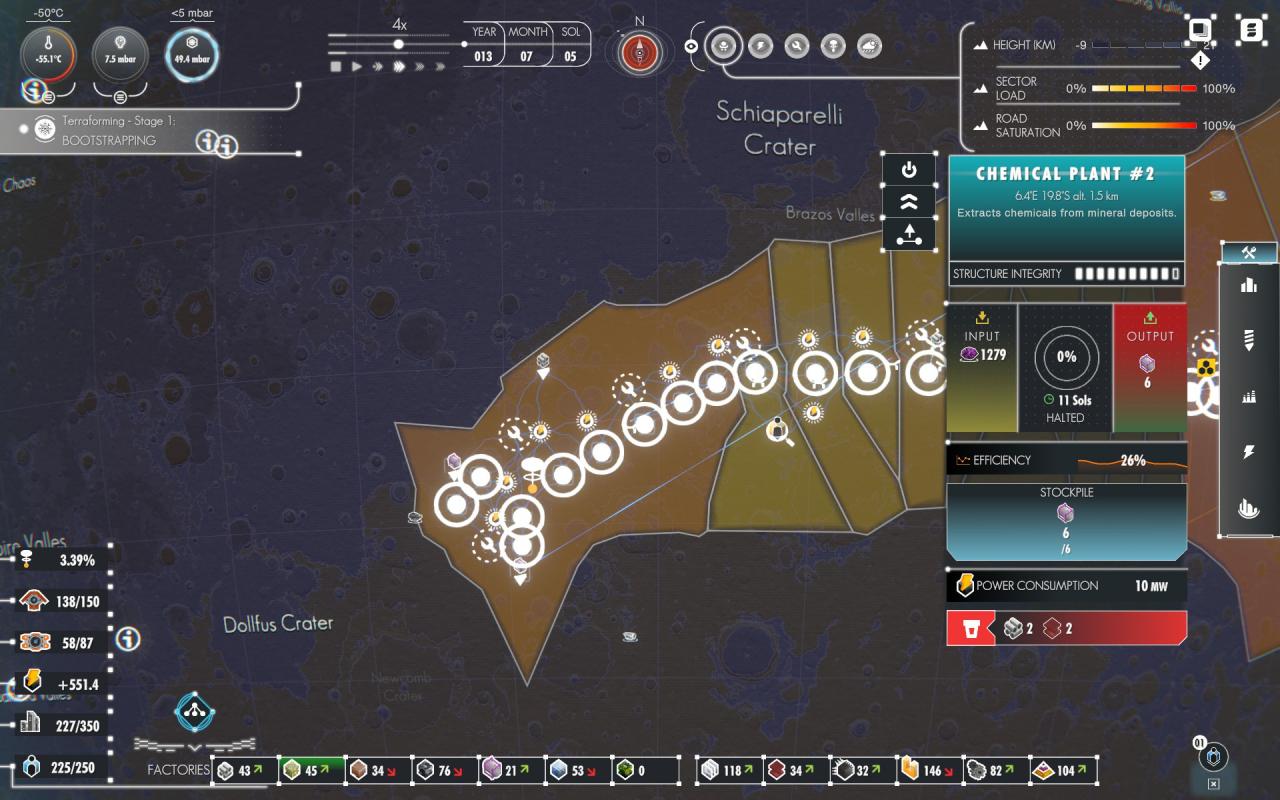 In this case, however, demand was present, so the problem was logistical. A quick switch to the “Worker” lens revealed the problem.
In this case, however, demand was present, so the problem was logistical. A quick switch to the “Worker” lens revealed the problem.
Drone hubs alone aren’t enough — you actually have to build drones for them to help. As it is, a single drone was trying to service an enormous territory (including two chemical mines and an aluminium mine) and failing. Note that the territory color is not red — which is why the “worker efficiency” rating is so useless.
Many players in this situation would build a second food factory. This is a terrible idea, for two reasons:
- With two factories, chemicals and water will be divided evenly between them. This creates the possibility that one of the factories has water but no chemicals while the other has chemicals and no water. In that situation, nothing is produced, and efficiency goes down.
- Secondly, it doesn’t matter how much demand (by building more factories) you generate — if the resources are bottlenecked by logistics production isn’t going to occur.
In this specific scenario, the correct solution does turn out to be “build a new factory” — a worker factory. I would have preferred to wait until the Factories II research had completed (again, two factories is much easier to manage than two), but… Needs must.
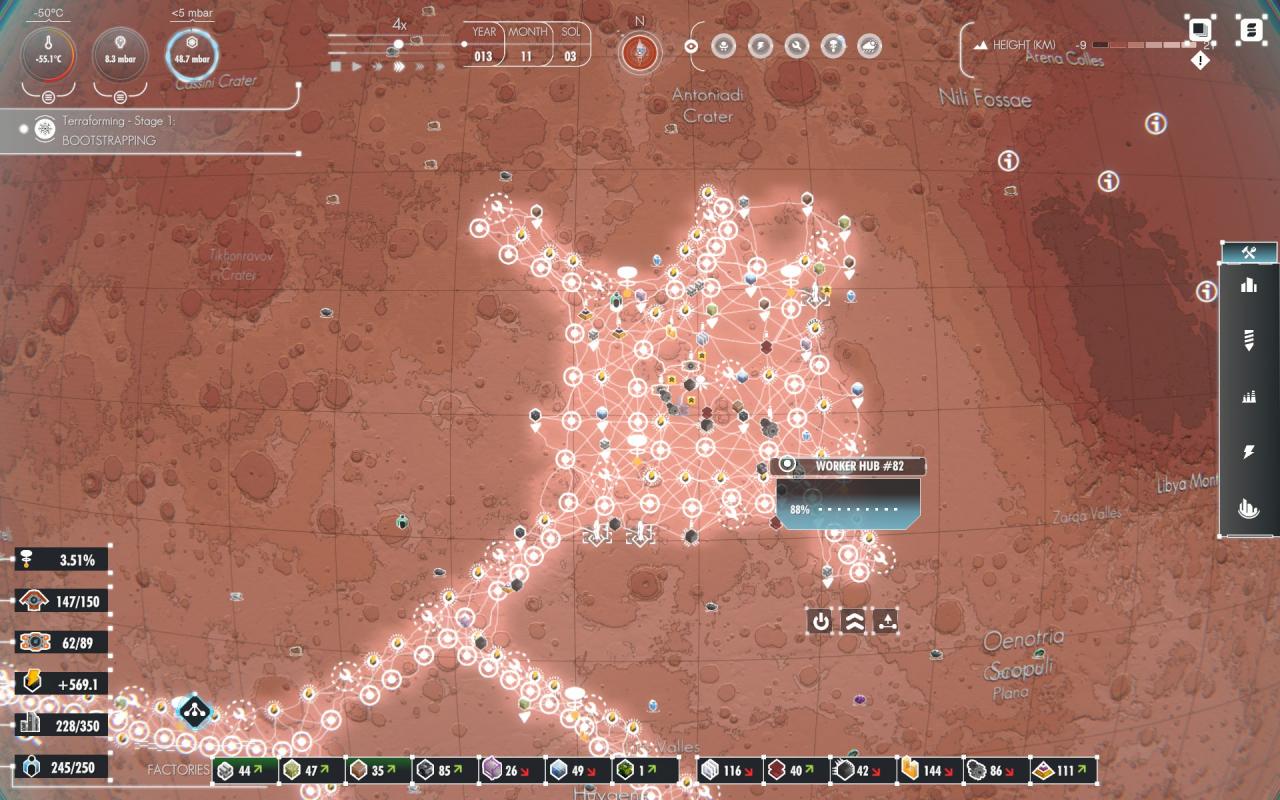 I also noted at this point that I needed to up my steel production, and started a new spur towards the iron patch. Helpfully, the iron patch also had some nearby carbon, which is also required for steel manufacture.
I also noted at this point that I needed to up my steel production, and started a new spur towards the iron patch. Helpfully, the iron patch also had some nearby carbon, which is also required for steel manufacture.
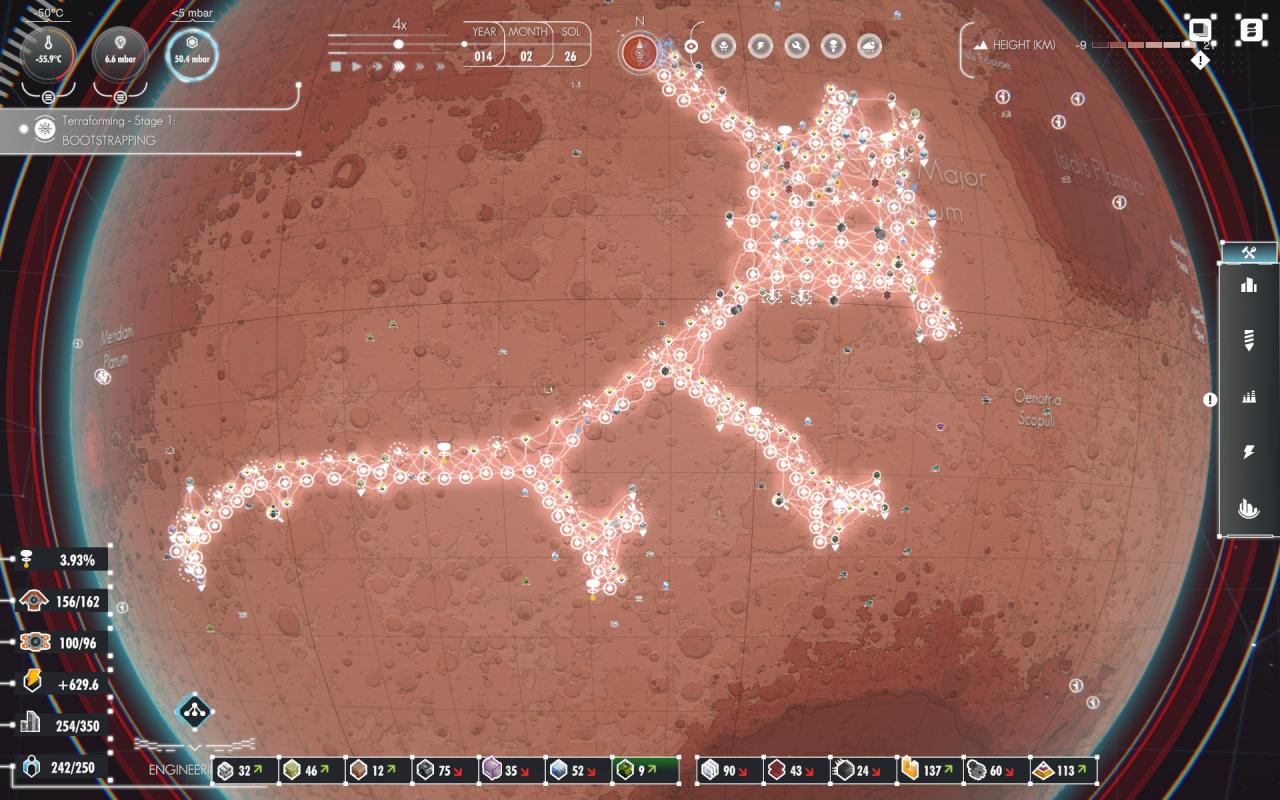 Year 14 brought the start of uranium mining (finally) and exploitation of the aluminium patch. I also finally finished researching “Factories 2” and upgraded most of my factories to level 2 (one at a time — a factory being upgraded can’t produce anything).
Year 14 brought the start of uranium mining (finally) and exploitation of the aluminium patch. I also finally finished researching “Factories 2” and upgraded most of my factories to level 2 (one at a time — a factory being upgraded can’t produce anything).
Research moved to Engineering 3 — I want my hyperloops. 🙂
At this point I finally used the microsuns and nuked Mars. Got the achievement too. 🙂
Walkthrough part 2
Year 15 started a new terraforming stage, so I figured it was a good time to take inventory — and, in particular, to prove that yes, it is possible to have 90% efficiency without using hyperloops.

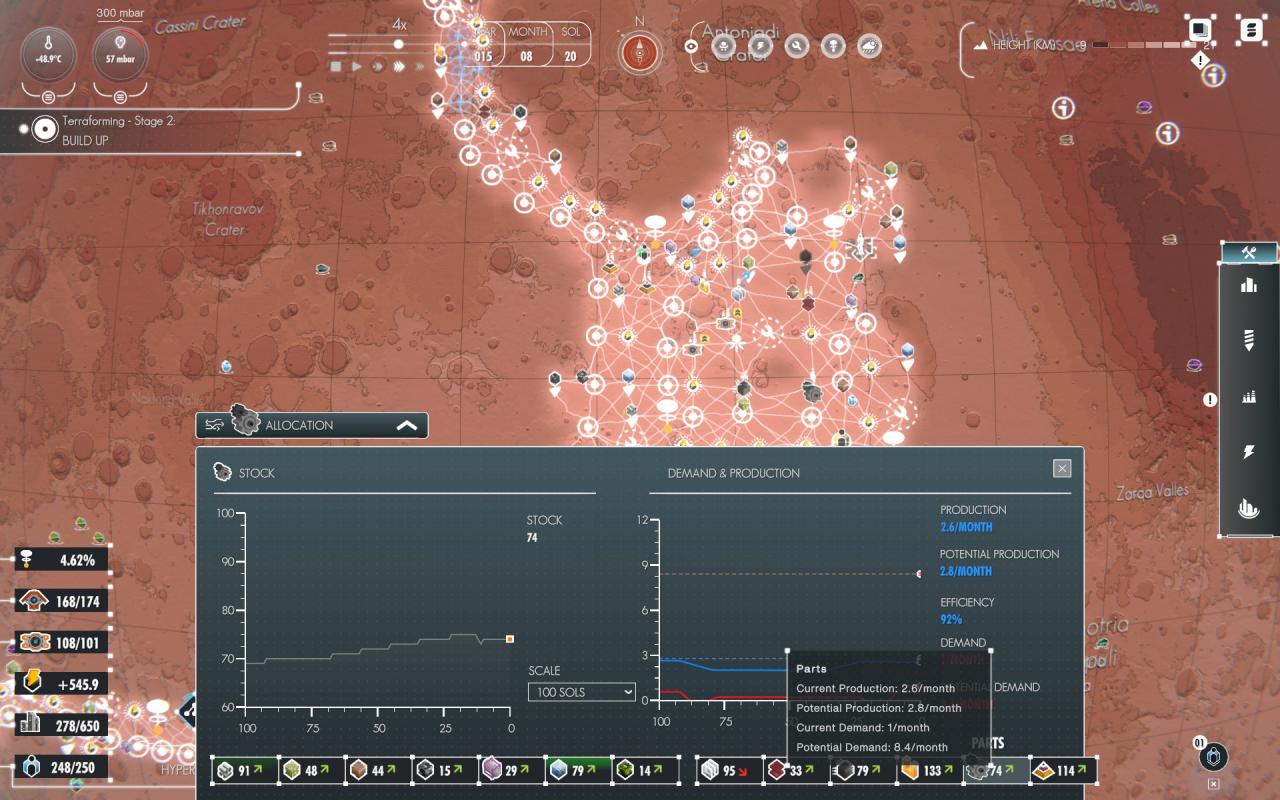
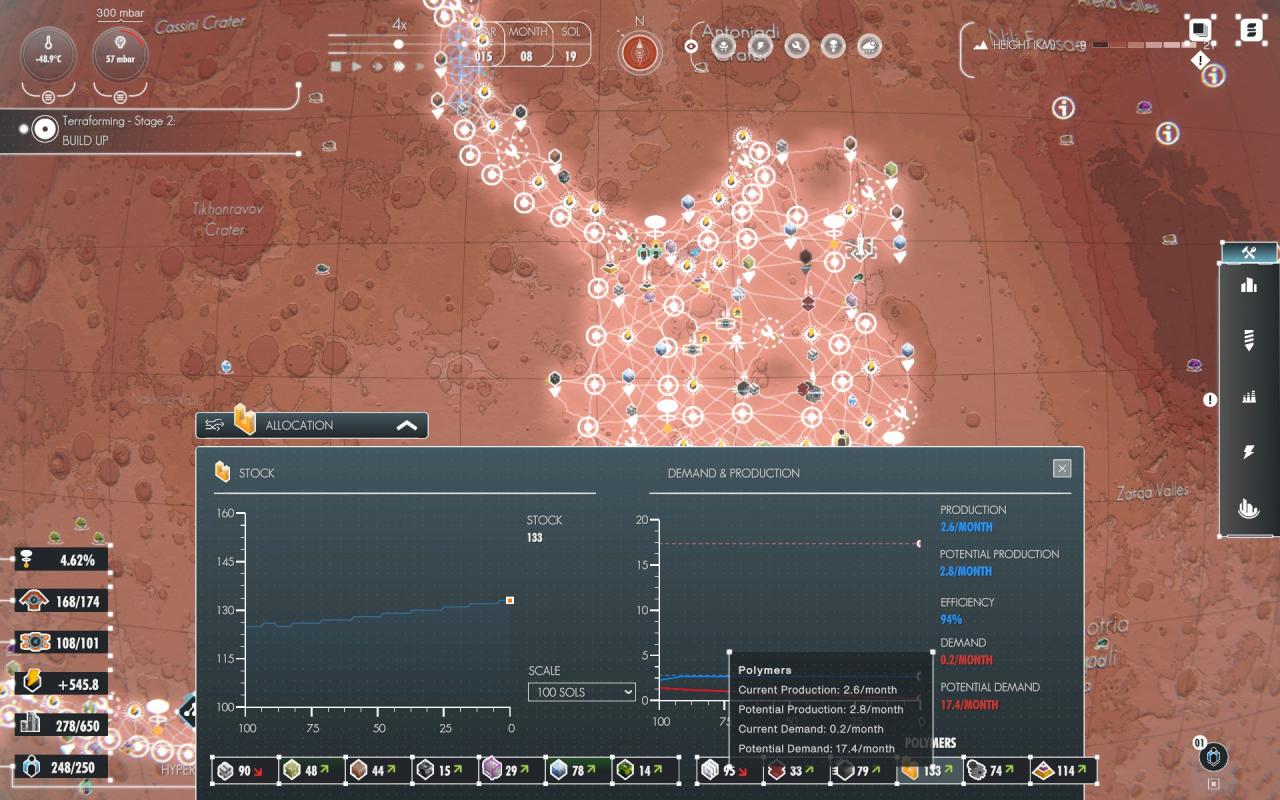
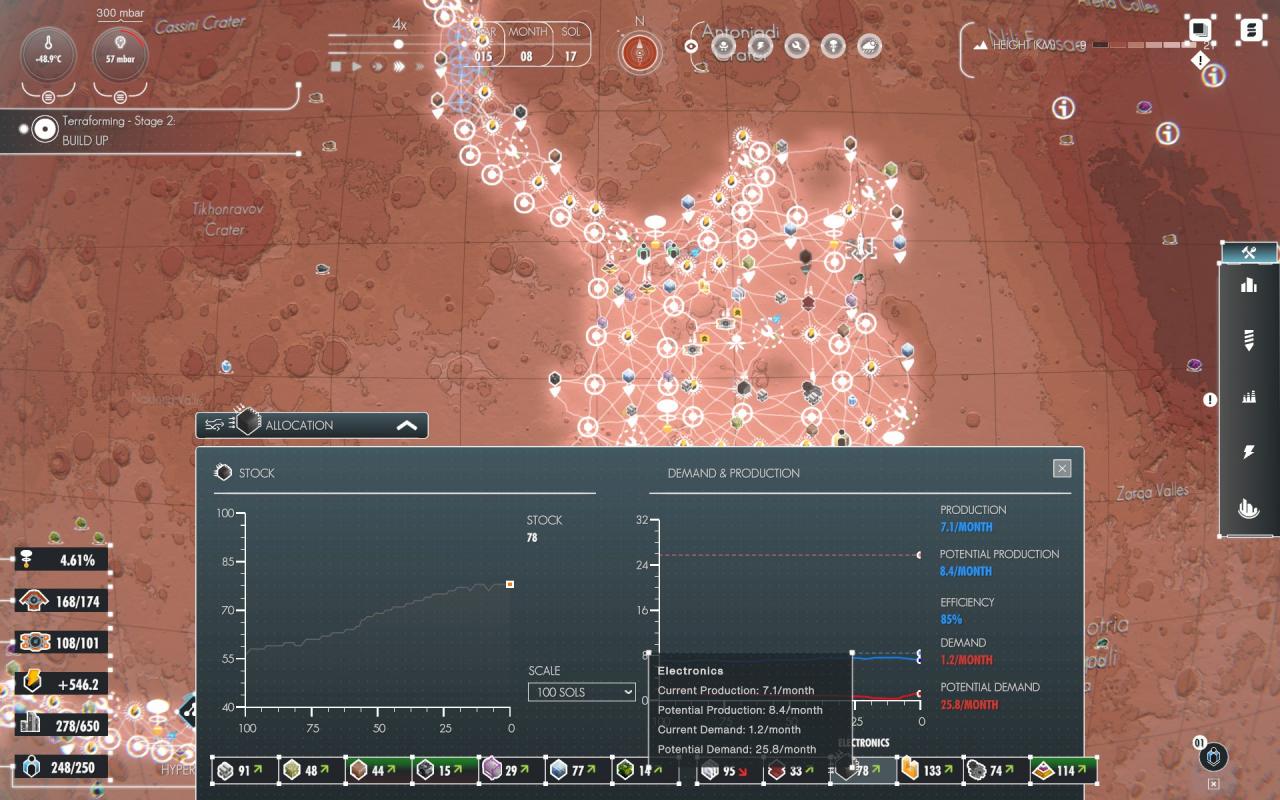
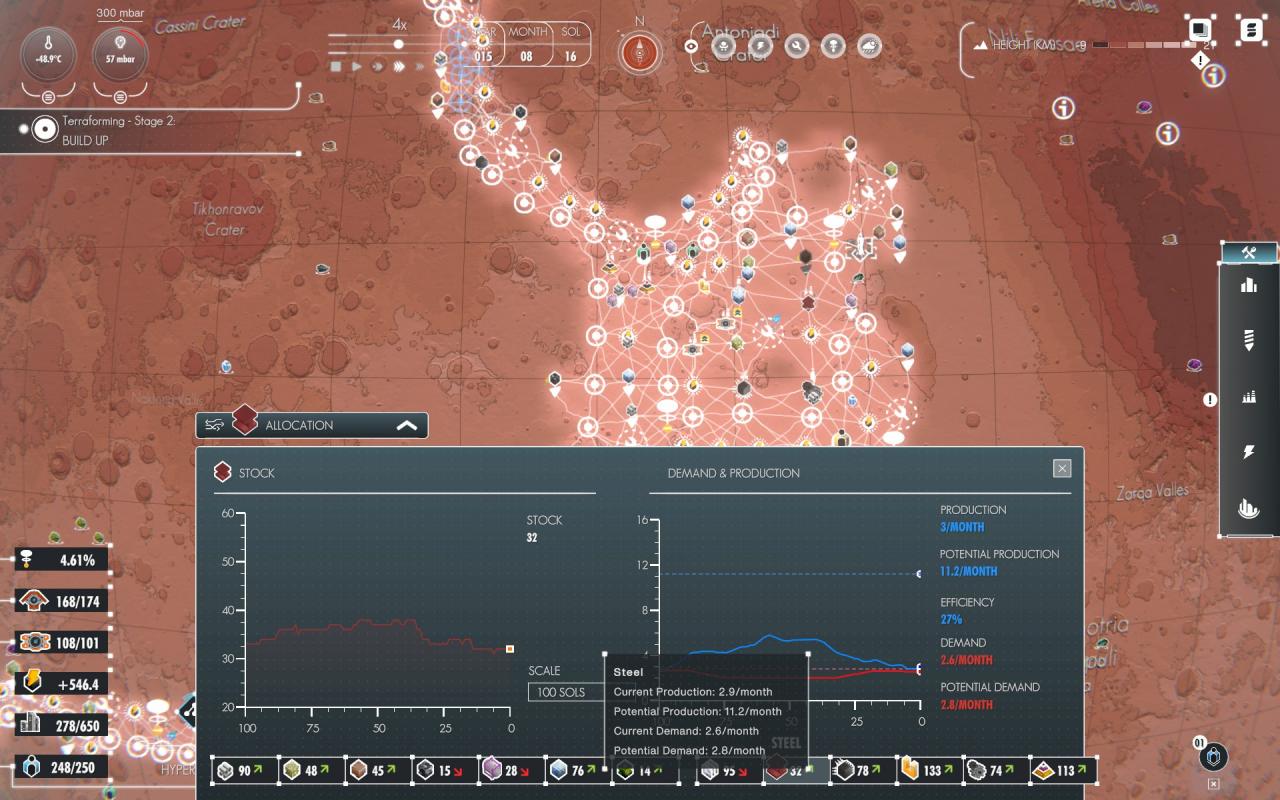
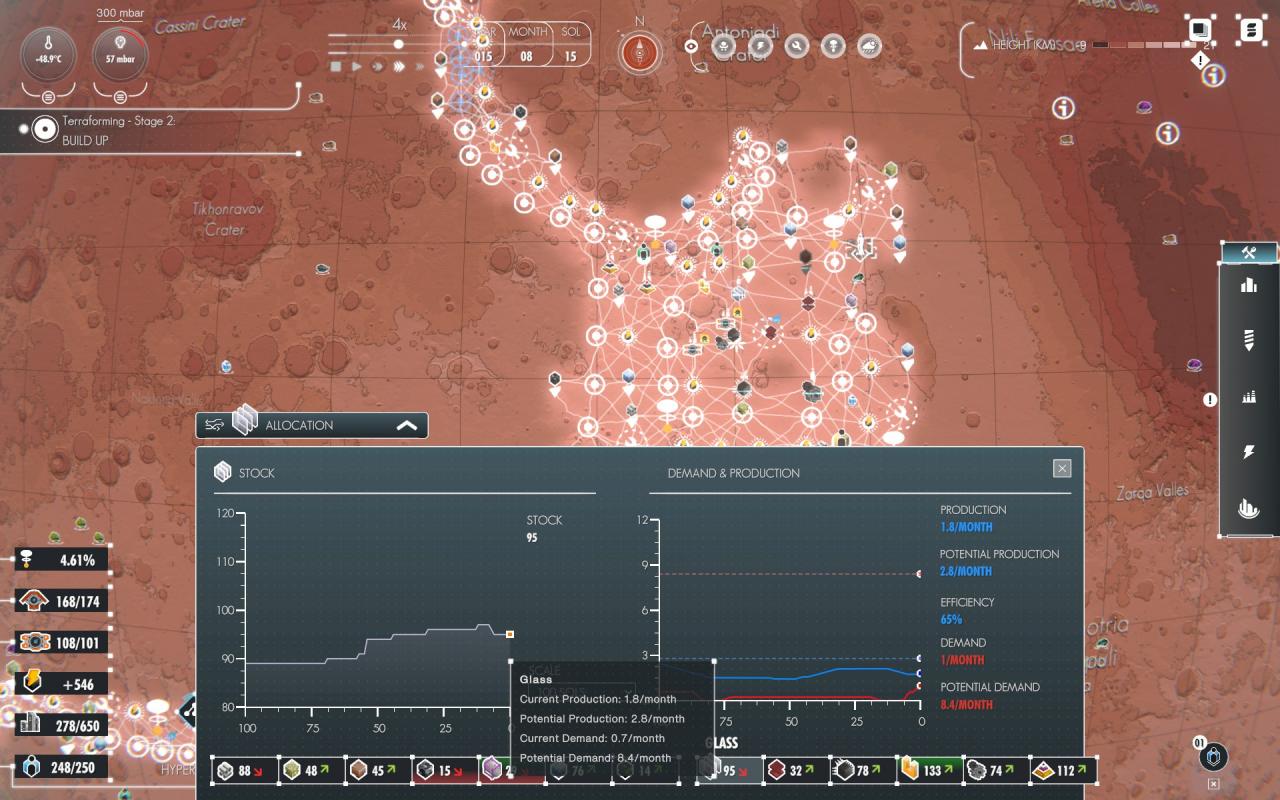
Note that food production is demand limited (I only have one Colony and a couple of Research Posts, and all of them were full of food, and the storage in the landing site was full as well — so the food factories were sitting with full outputs, which isn’t a problem).
The steel production stands out, obviously — thus the work on the northwest spur, to further exploit the iron field that resides in that direction.
Oh, and I decided I needed some more research outposts (for both population and the R&D bonus) — if my food factories are stalling due to lack of demand, then I might as well expand my population, right?
And I aborted my research of Hyperloops, which was taking forever, and moved to researching “Import greenhouse gases” — which I’ll use to complete the next phase of terraforming.
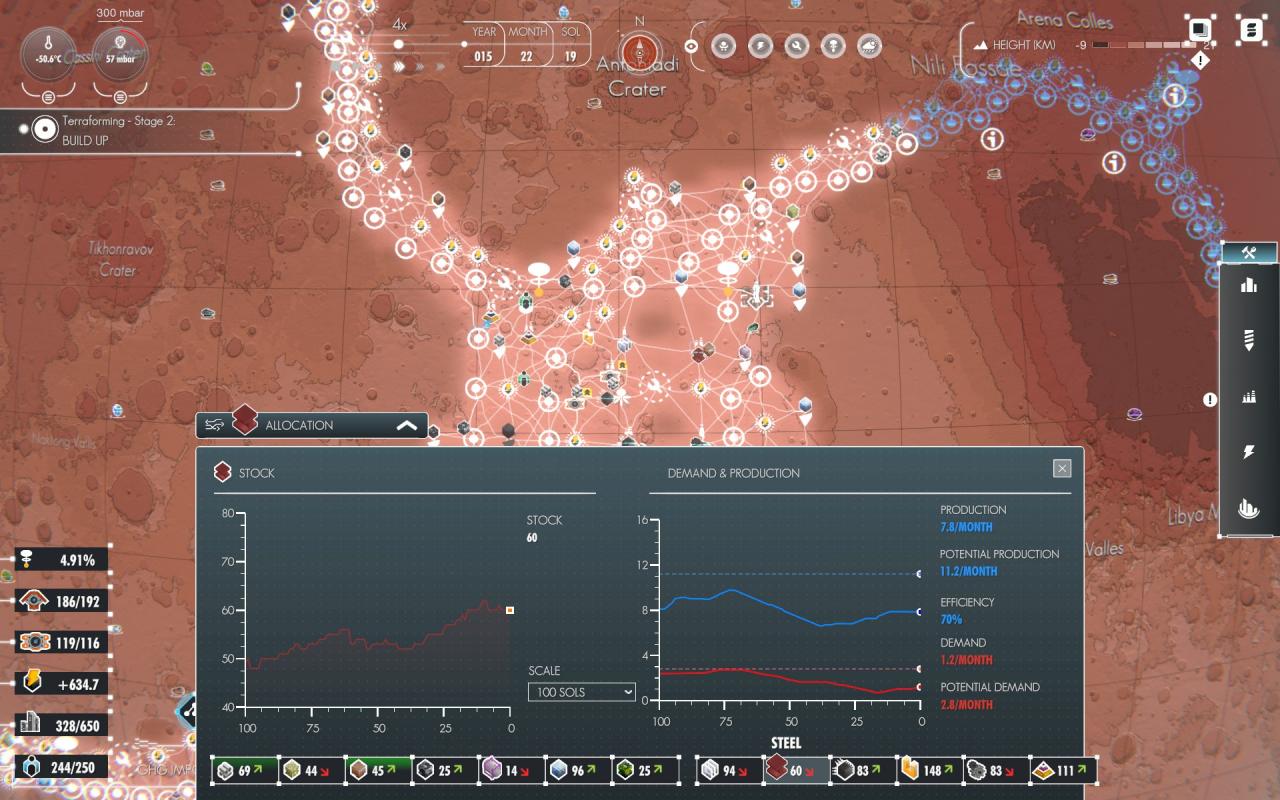 The additional iron and carbon signficantly improved my production of steel.
The additional iron and carbon signficantly improved my production of steel.
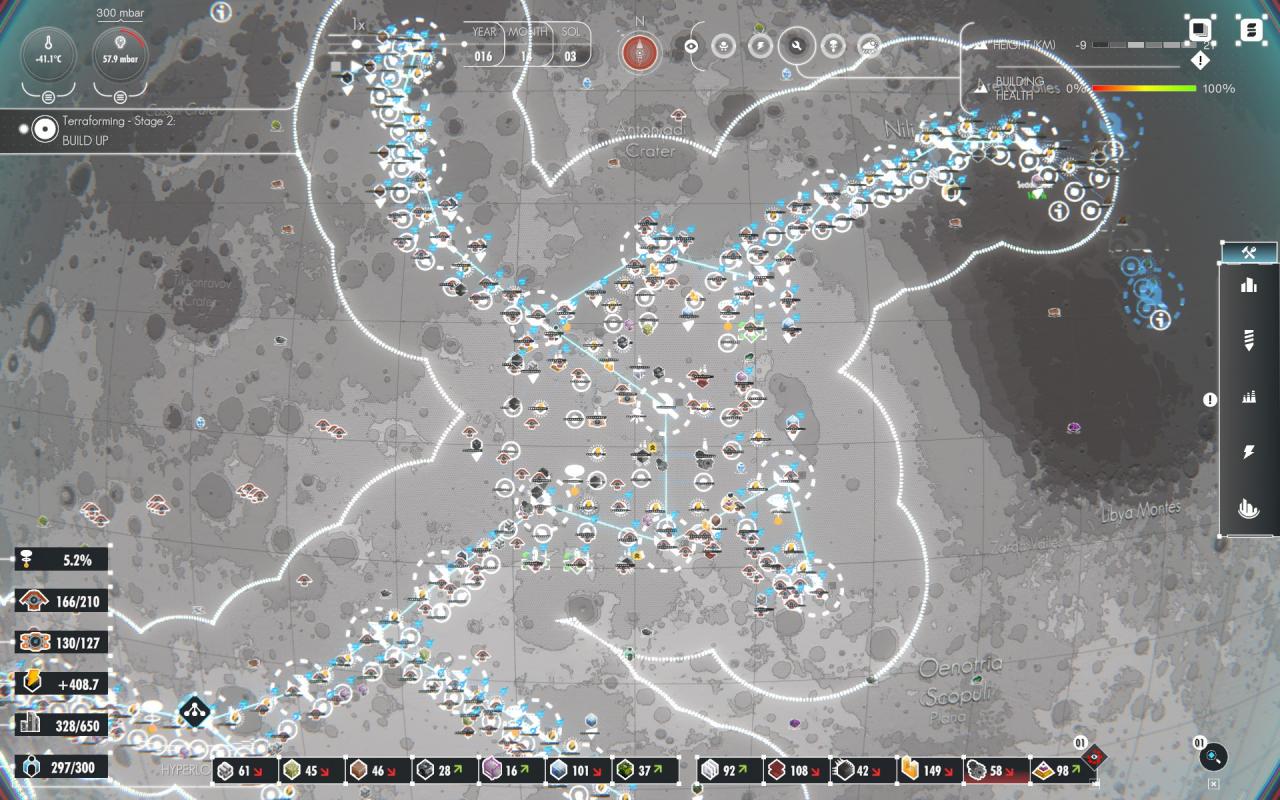 Year 16 triggered the deadly sneak attack. As always, damage was widespread, but the maintenance drones were on the job — and dropping like flies, of course.
Year 16 triggered the deadly sneak attack. As always, damage was widespread, but the maintenance drones were on the job — and dropping like flies, of course.
The solution for this particular crisis is straightforward:
- Make sure you have a large quantity of “Electronics” and “Plastics” on hand. Generally speaking, you’ll have a full (all storage filled, all maintenance towers full, and factory output full) set of plastics by the time you get to this point — other than maintenance drones, nothing else requires it, so it tends to accumulate in large quantities in maintenance towers naturally. Electronics, on the other hand, tends to be a problem. To address this:
- Suspend (turn off) any ongoing construction and spaceports with reoccurring missions (in my case, two spaceports running the “Import Greenhouse Gases” repeatable mission). Most construction requires electronics to complete, and you want to make sure the only thing consuming electronics is the maintenance towers.
- Put priority on all of your electronics factories. Remove priority from anything that consumes electronics — specifically, the worker factory. Again, you want to make sure the maximum number of electronics are available to the maintenance towers.
- Wait
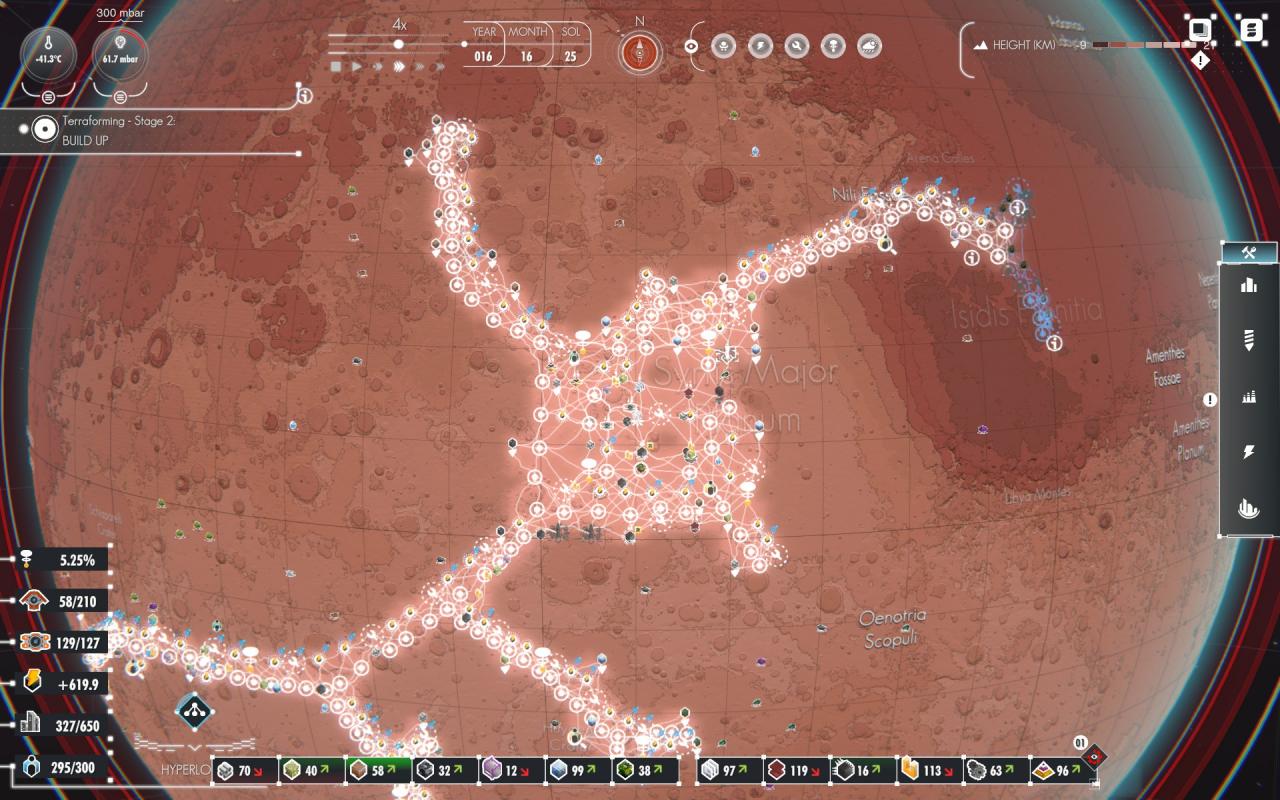 At this point the number of maintenance drones had started to rebound. Still not time to celebrate, but once the number of maintenance drones stops going down, you are likely out of the woods.
At this point the number of maintenance drones had started to rebound. Still not time to celebrate, but once the number of maintenance drones stops going down, you are likely out of the woods.
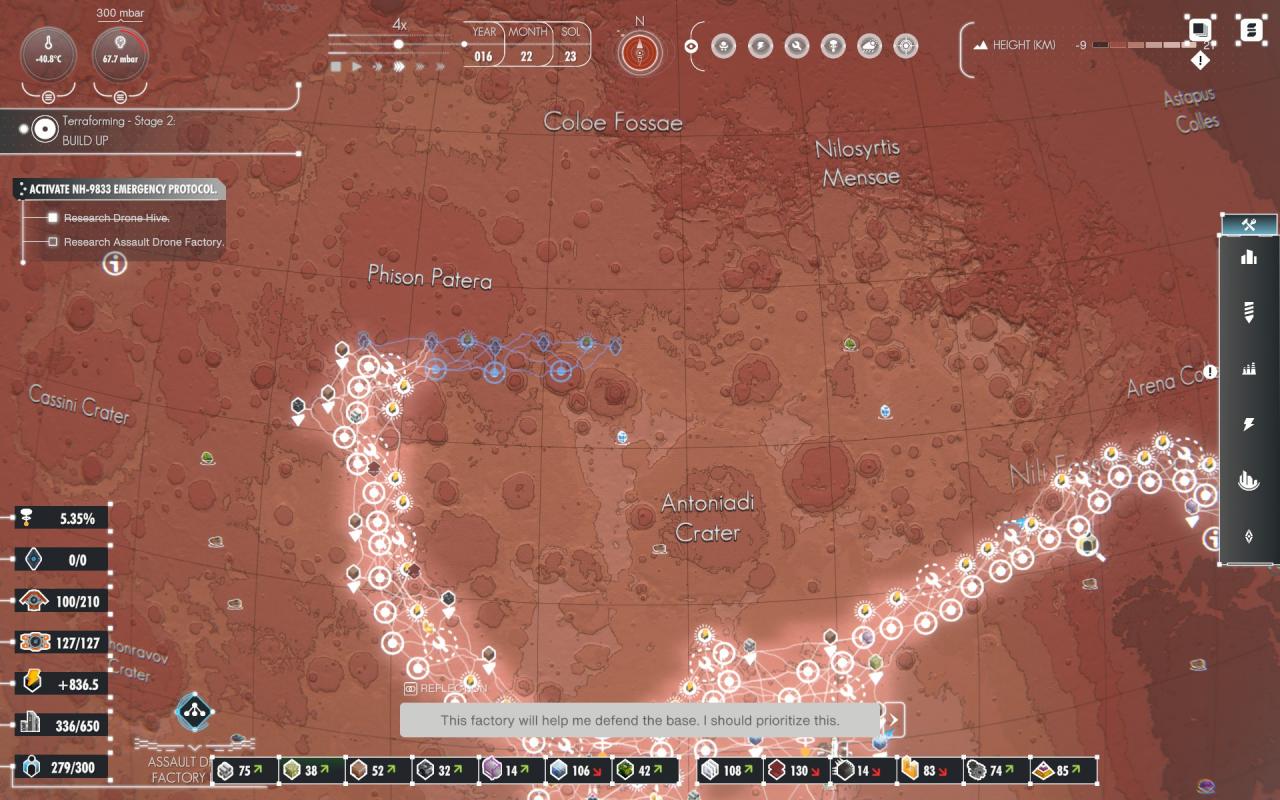 Once the military research tree is unlocked, you should stop whatever you are researching and switch to researching drone hives. Once you have drone hive researched, build a row of them across the northern most extent of your base. In my case this was the northern spur — not desirable, but that’s where the iron was. Yes, this costs electronics: hopefully, your maintenance drone situation has improved from “dire” (25-45%) to “worriesome” (45%-65%). If you are still in “panic” state (<25% of your maximum capacity) and you’ve gotten to this point you are, more than likely, doomed.
Once the military research tree is unlocked, you should stop whatever you are researching and switch to researching drone hives. Once you have drone hive researched, build a row of them across the northern most extent of your base. In my case this was the northern spur — not desirable, but that’s where the iron was. Yes, this costs electronics: hopefully, your maintenance drone situation has improved from “dire” (25-45%) to “worriesome” (45%-65%). If you are still in “panic” state (<25% of your maximum capacity) and you’ve gotten to this point you are, more than likely, doomed.
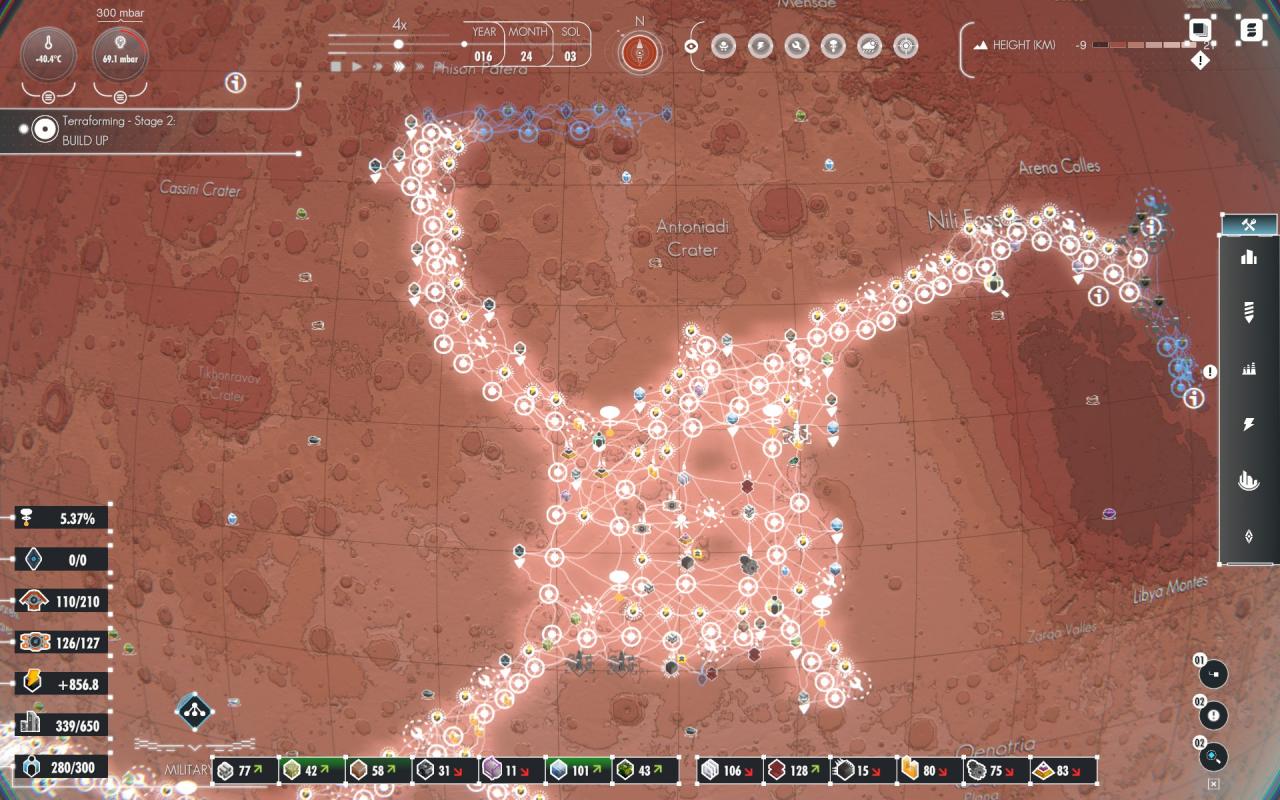 Once you’ve researched it, build the assault drone factory. Yet another thing to consume electronics — make sure you are still making progress towards restoring your maintenance drones, and don’t start anything new.
Once you’ve researched it, build the assault drone factory. Yet another thing to consume electronics — make sure you are still making progress towards restoring your maintenance drones, and don’t start anything new.
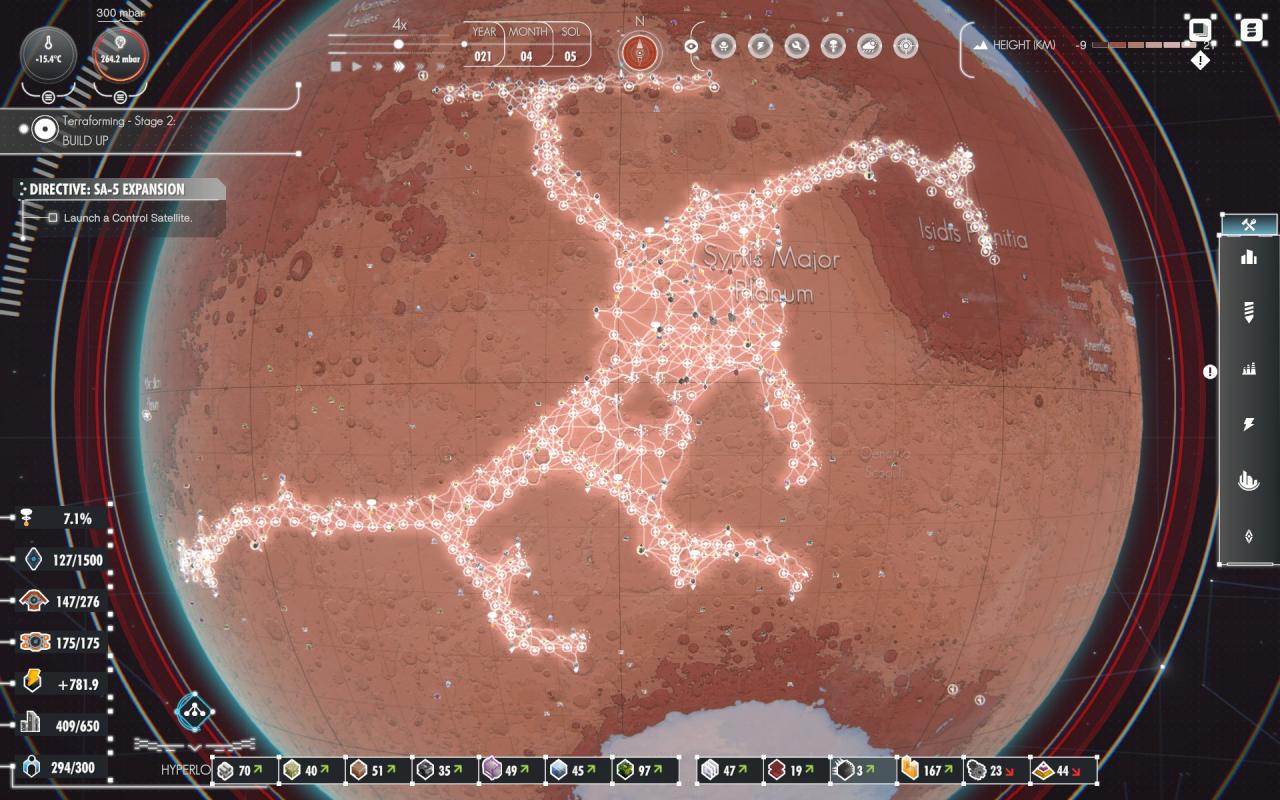 Most of a year later, sitting at 192/210 maintenance drones I cautiously restarted construction — in this case, new construction, because now that my plastic factory was actually producing plastic (to replace the plastic that the maintenance drones consumed) my food production was down due to lack of supply. So expanding and building some new chemical mines seemed like a good idea.
Most of a year later, sitting at 192/210 maintenance drones I cautiously restarted construction — in this case, new construction, because now that my plastic factory was actually producing plastic (to replace the plastic that the maintenance drones consumed) my food production was down due to lack of supply. So expanding and building some new chemical mines seemed like a good idea.
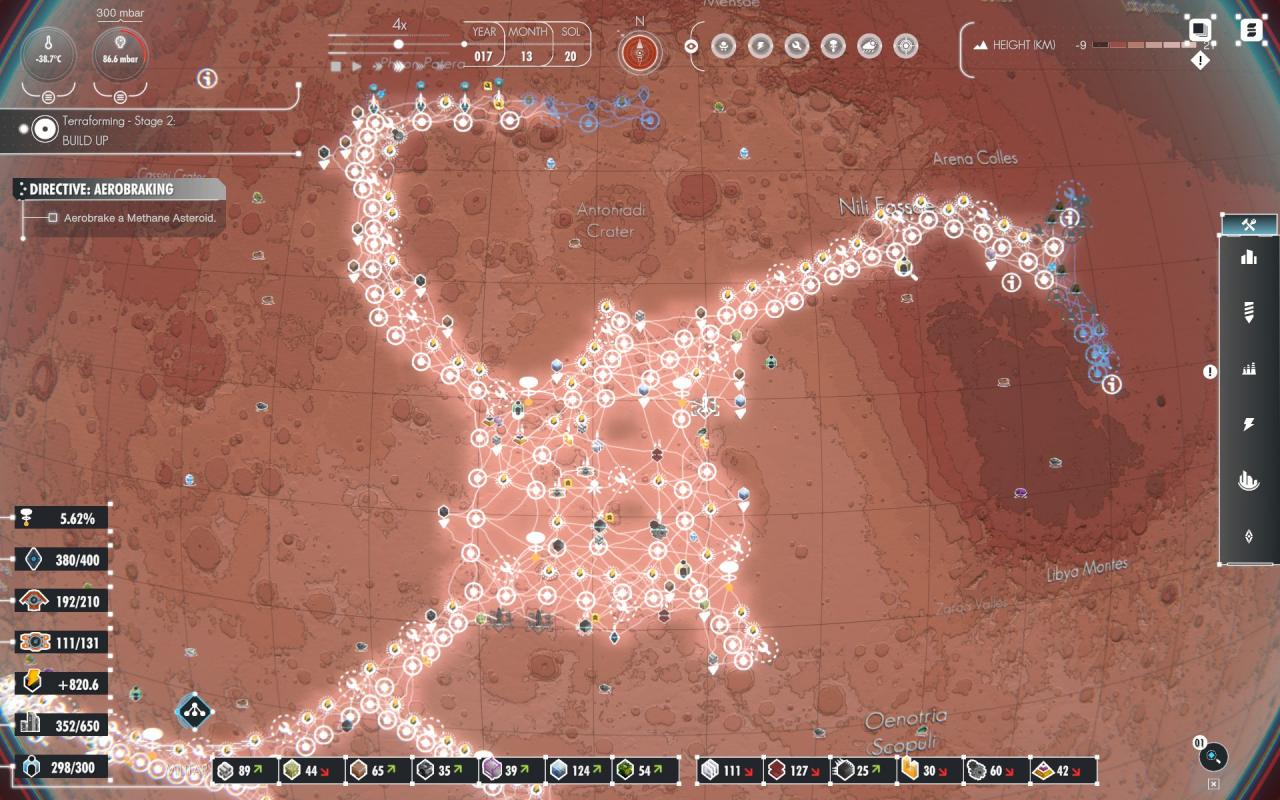 Extending the picket line of drone hives, production of drones is underway. Worker drone levels are dropping pretty significantly here, so I restored the priority to one of the Worker factories and removed it from the assault drone factory, knowing that I had enough assault drones to defeat the first attack.
Extending the picket line of drone hives, production of drones is underway. Worker drone levels are dropping pretty significantly here, so I restored the priority to one of the Worker factories and removed it from the assault drone factory, knowing that I had enough assault drones to defeat the first attack.
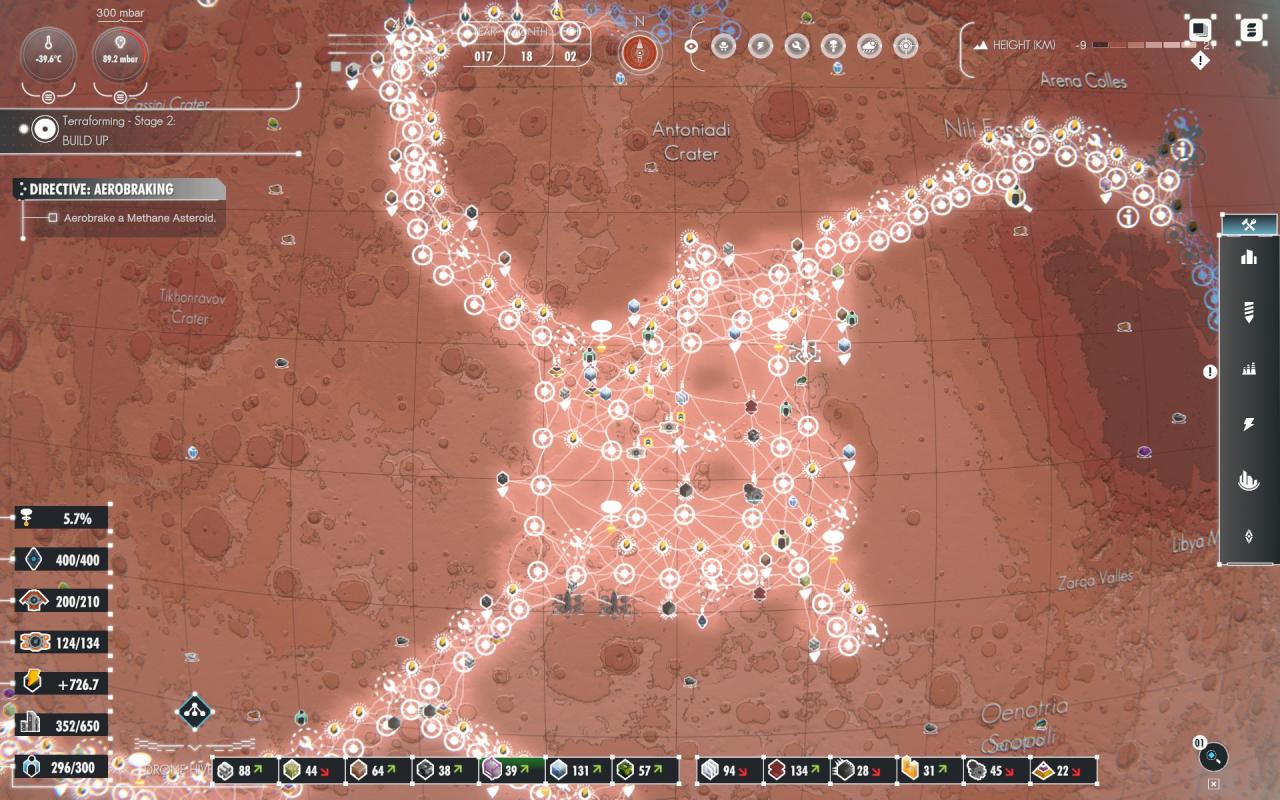 Finally I’m satisfied with my maintenance drone population (200 /210) and remove priority from the electronics factories and restore it to both of the worker drone factories.
Finally I’m satisfied with my maintenance drone population (200 /210) and remove priority from the electronics factories and restore it to both of the worker drone factories.
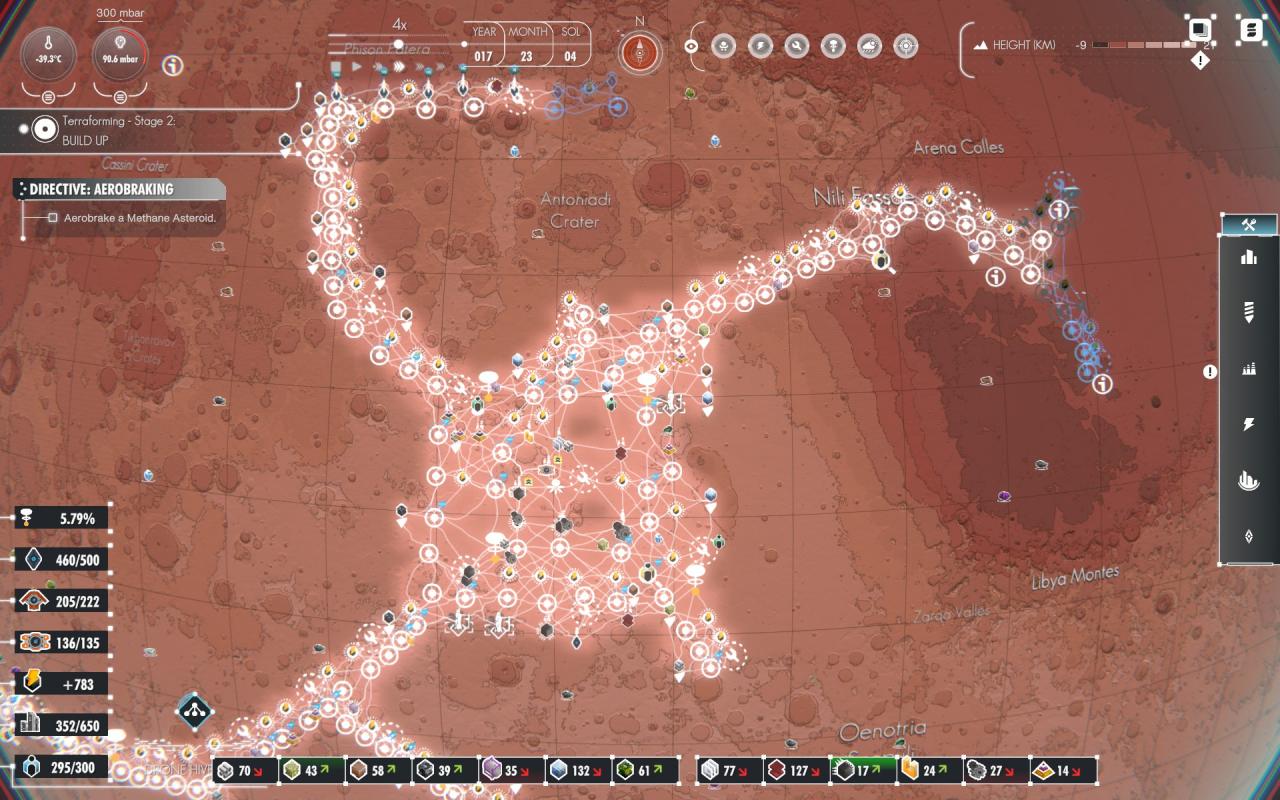 Restarting the spaceports (importing greenhouse gases, still).
Restarting the spaceports (importing greenhouse gases, still).
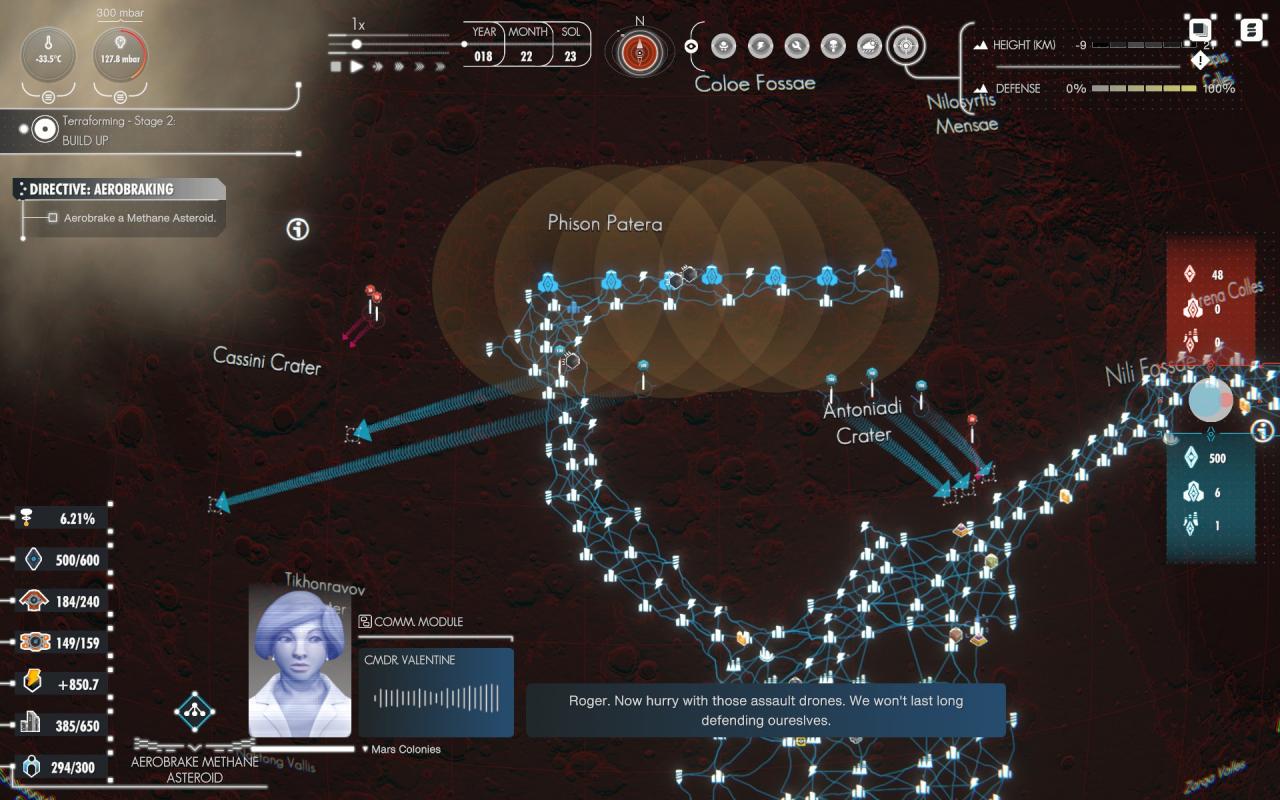 The first attack (well, the first one with drones). Note that you need to manually vector your drones (left click on the number above the drones to select them, then left click on the map to specify a direction) as the drones won’t compute efficient intercepts on their own.
The first attack (well, the first one with drones). Note that you need to manually vector your drones (left click on the number above the drones to select them, then left click on the map to specify a direction) as the drones won’t compute efficient intercepts on their own.
Also, note that drone hives themselves function as defensive towers — when powered, they attack enemy drones within the shaded area. They are very powerful attackers, but proper positioning is difficult.
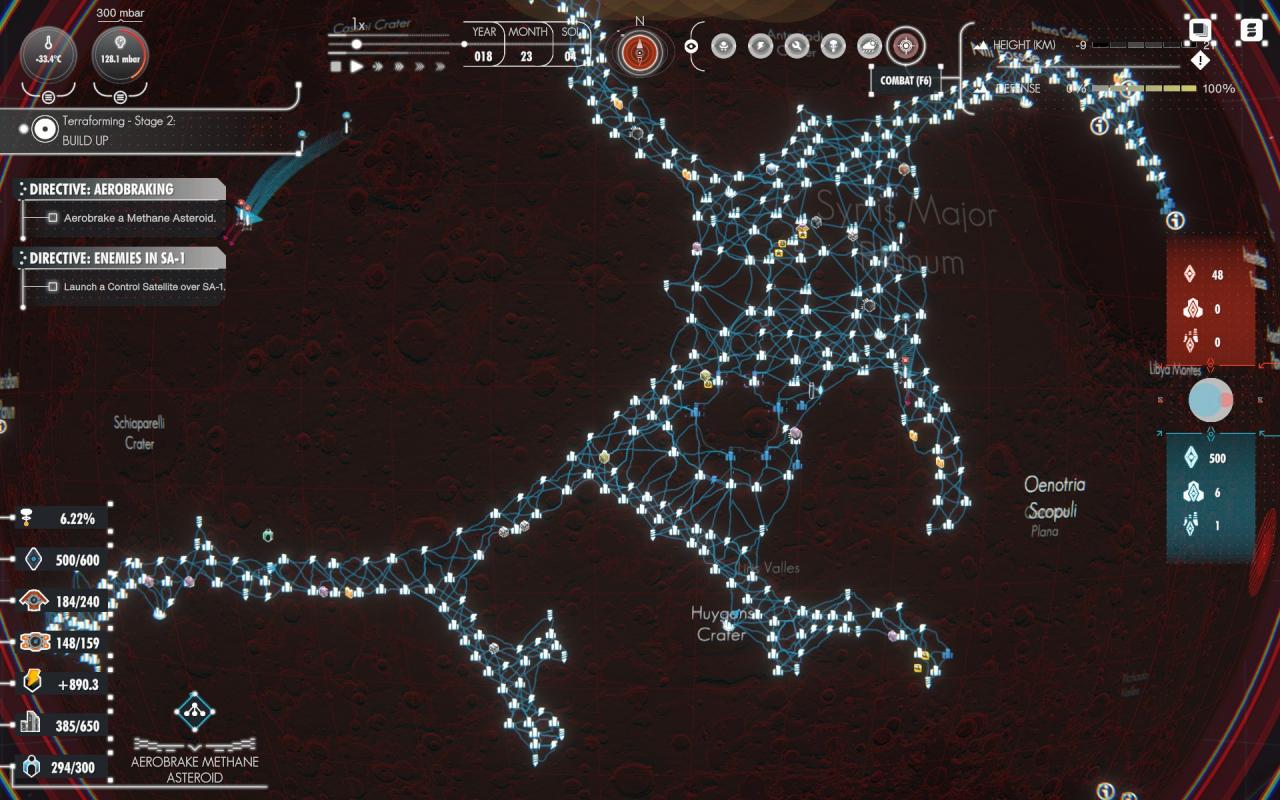 Settling in for a long tail chase. If you can’t get ahead of the enemy drones, you might as well as target the enemies directly (left click on the number above your drone, then left click on the number above the enemy drone). This will set your drones to follow the enemy wherever they go.
Settling in for a long tail chase. If you can’t get ahead of the enemy drones, you might as well as target the enemies directly (left click on the number above your drone, then left click on the number above the enemy drone). This will set your drones to follow the enemy wherever they go.
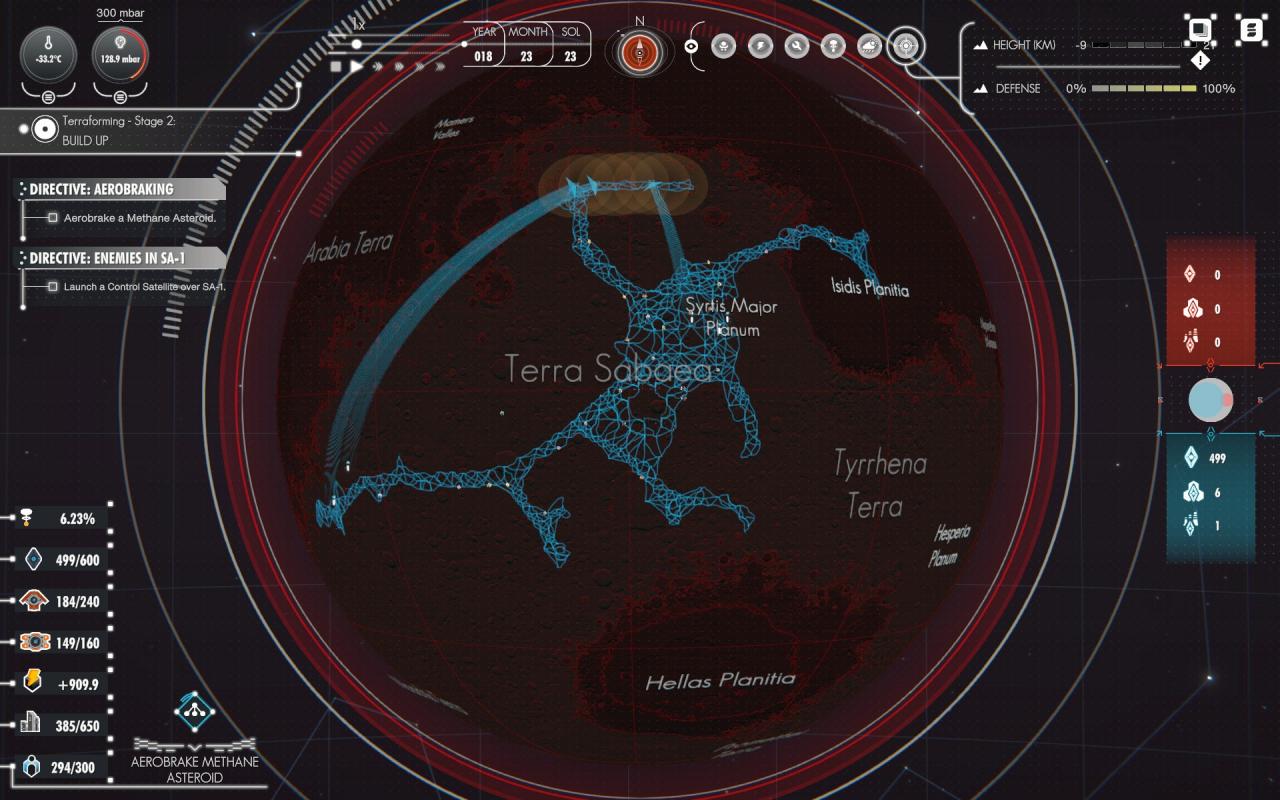 All enemies dead (with some damage to my base), returning to base.
All enemies dead (with some damage to my base), returning to base.
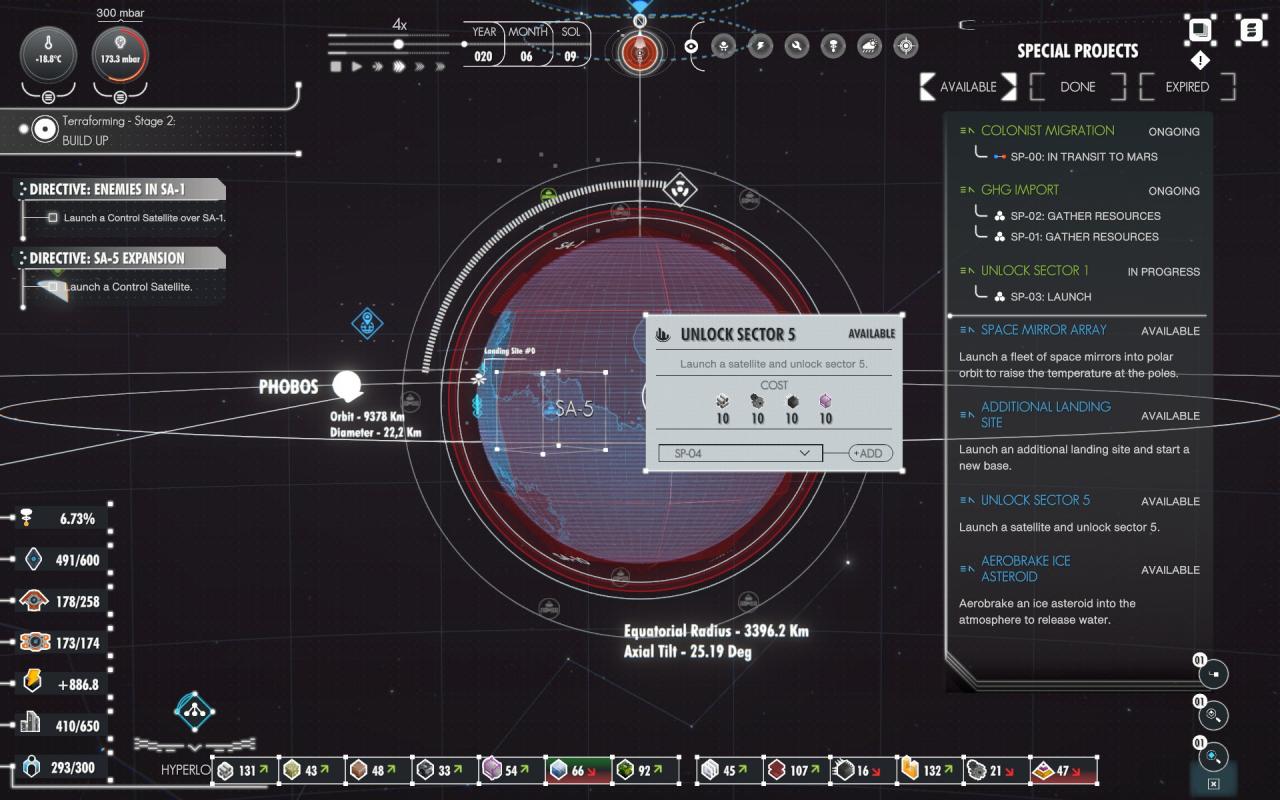 Starting the process to unlock SA-1
Starting the process to unlock SA-1
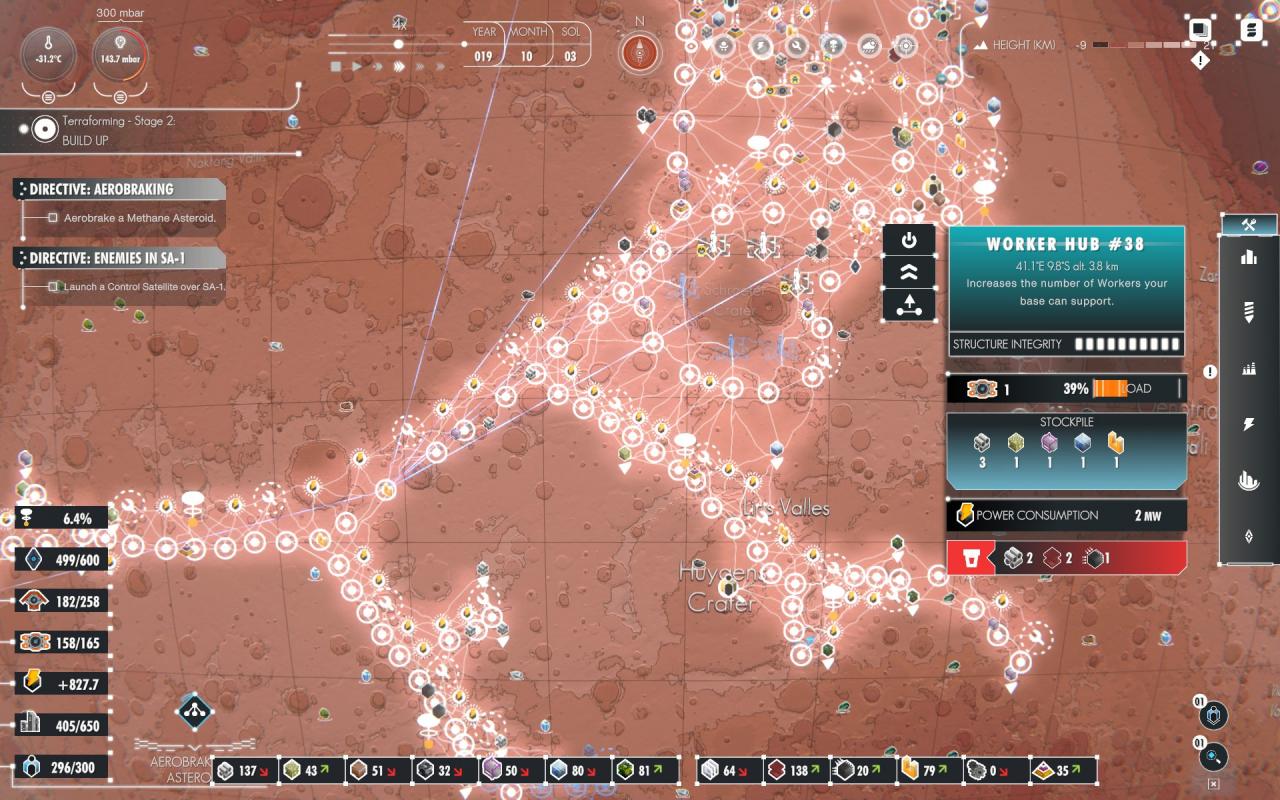 Found a bottleneck when I clicked on this node by accident.
Found a bottleneck when I clicked on this node by accident.
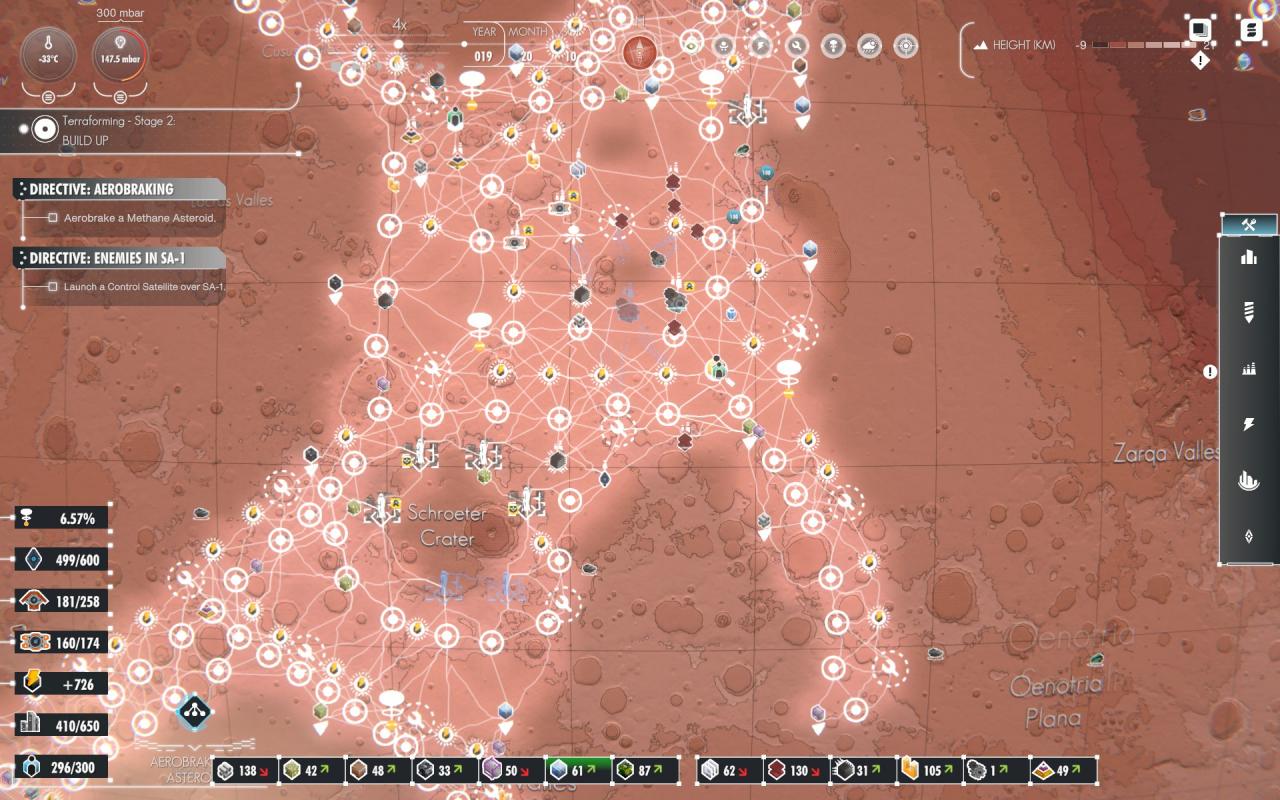 Fixed the bottleneck by adding a third strip of worker drones along that segment. I also started building additional spaceports (up to my limit) and finally bit the bullet and built a second parts factory.
Fixed the bottleneck by adding a third strip of worker drones along that segment. I also started building additional spaceports (up to my limit) and finally bit the bullet and built a second parts factory.
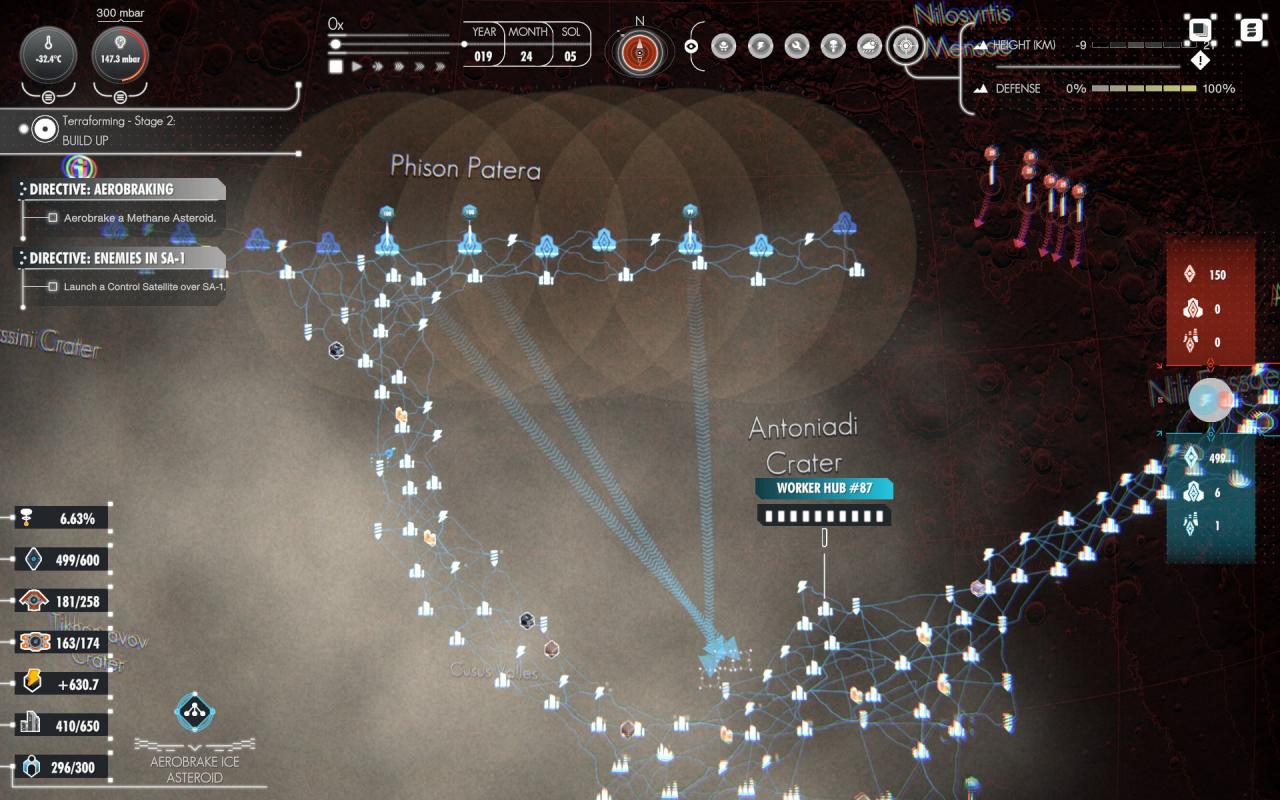 The second attack. Sorry about the poor screenshot clarity — there was a dust storm in progress and I paused the game, so the picture is pretty noisy. The attack was easily repelled.
The second attack. Sorry about the poor screenshot clarity — there was a dust storm in progress and I paused the game, so the picture is pretty noisy. The attack was easily repelled.
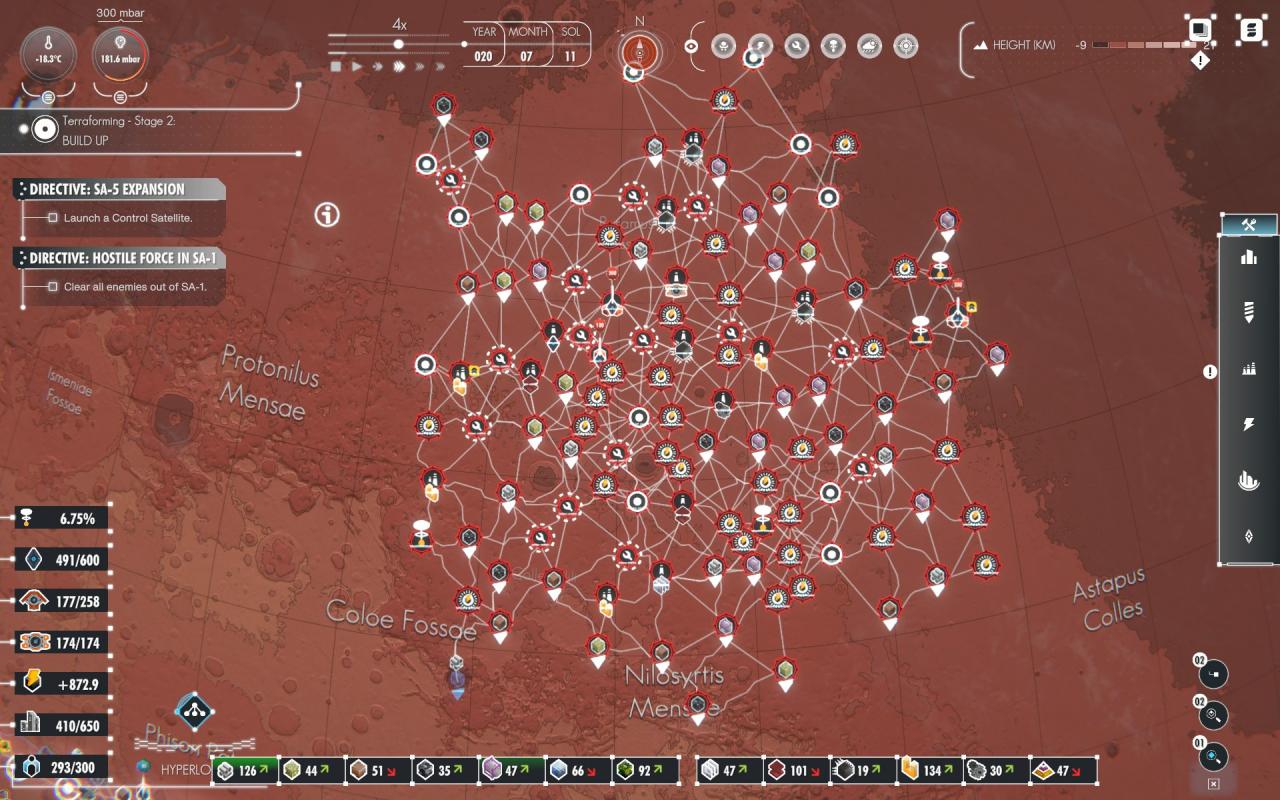 The enemy base is revealed (once the unlock for SA-1 completes).
The enemy base is revealed (once the unlock for SA-1 completes).
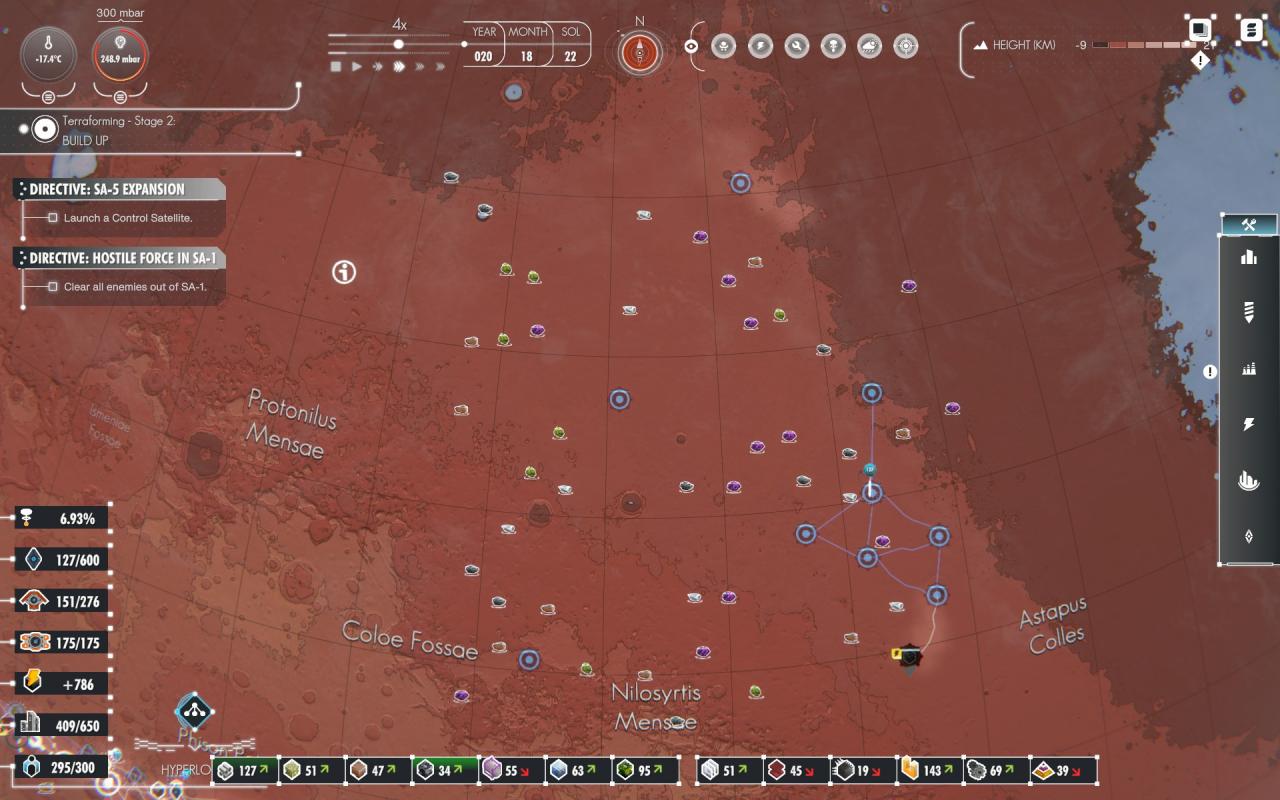 The enemy base is destroyed — victory is mine! And lots of resources to exploit is good too.
The enemy base is destroyed — victory is mine! And lots of resources to exploit is good too.
Walkthrough Conclusion
Unless there is enormous amounts of demand, I’m not going to continue the walkthrough after this. I may post a separate guide for running a hyperloop based economy, but being efficient isn’t critical after you destroy the first base.
That’s all we are sharing today in Per Aspera Logistics System Guide, if you have anything to addm please feel free to leave a comment below, and we’ll see you soon.
Credit to mreed2
